#i need 2 gather data . its like therapy to me
Explore tagged Tumblr posts
Text
#currently suffering from anxiously attached bitch disease#i need 2 gather data . its like therapy to me#polls#text
5K notes
·
View notes
Text
Charcherry Weekly - Issue 218
Hello everyone, Mage of Light Nick Card here. Its starting to get cold enough to wear jackets again! My favorite kind of weather! Now for some actually important news.
Cecelia and Ada
Early this week, Witch of Heart Cyrus brought home an android of seemingly unknown origin. The hard drive was encrypted, so Mage of Life Blaze installed a new solid state drive. Her name is Cecelia and she is considered a daughter to the two of them. Not too long after, your dear newsletter writer was summoned to try and decrypt the drive, but Blaze was coughing up a storm and Cyrus was practically asleep so it didn't seem like the right time to take a crack at it. A few days later, Cyrus called me over once more and this time I got a solid chance to investigate. Rather than using my light powers, I simply searched on the desktop and found the chumhandle of an important contact. I contacted them and was able to obtain the password by proving myself trustworthy. It took overnight for the hard drive to complete its decryption, but by morning, it was ready to be installed once more. The android, now bearing two drives, now has both the new and old identities. The one from the hard drive is known as Ada. Cyrus and Blaze care for and support both of their daughters, and hope that both of them can live a better life under their roof.
Grid mission... 2!
Yesterday as of writing, there was a mission to liberate the town of RollerDome. A team was assembled at the Friendship Network to tackle it. Those who went on the mission included Splashwoman.exe, Enker.exe, *Aperture, and Research Agent Counterpoint. Reportedly, Counterpoint was created by The Curator of the Northern Frigid Archives of Korous to gather data in hostile locations. They departed for The Grid of the Land of Copper and Lasers (and Steam and Crossroads) together. DimentioBossFightDisguise also assisted them upon arrival, operating from the air. During the mission, they faced a swarm of kuramon, which were relatively easy to dispatch. However, the true danger arrived when they encountered a horde of zombie programs. While they were easy to fight in theory, the fight in practice was reportedly disturbing, and thus made more difficult as a result. Eventually, the squad arrived upon RollerDome, which had been taken over by Forygon, a Porygon-Z commander. Their final fight took place inside of the dome itself, where they were tasked with competing in a deadly team lightcycle match. There were a number of close calls, but fortunately the squad managed to make it through the match and destroy their enemies, including Commander Forygon. With their victory, *Aperture was given access to the control console, which allowed him to make the necessary changes to bring the town of RollerDome under resistance control. Reportedly, those that had been zombified will likely now be able to be restored from disc, thanks to a disc restructuring device that is now available for use. It is very likely that the squad will need time and support for recovery.
Classified ads
Rail engineers wanted! Contact theUnderground for details.
Do you need therapy? Have you been impacted by the cosmic creation game in some manner? Do you have weird problems that likely have supernatural factors? Contact Dr. Winters at 555-555-0125 (new number) to schedule an appointment, new client slots open in October.
Do you want an ad here? Contact lavenderSiren to get an ad for whatever. If you don’t write it yourself, you risk the newsletter writer writing it instead, do be warned.
This week’s known market stands in Desertia Town:
DTA train ticket stand
Katie’s potion stand (Not available to plitlanders due to regulations, available to all others however)
shinyjiggly pokesnacks stand (also has a Unity Village location!)
Brae's produce stall: - Potted vegetables - Jarred vegetables - Various jams
Enchantment store - Ioun stone (pink rhomboid) (8000 gp) (others) +2 upgrade bonus to CON. - Lesser Metamagic Scepter (3000 gp) (scepter) 3 / day you cast a maximum 3rd level spell as affected by Extend Spell. - Cobra Straps (1400 gp) (feet) After an unarmed charge attack, you can move 5 '(Gharyn's Monastic Garb). - Crystal of Alacrity (3500 gp) (glass prot.) +5 'morale bonus to speed (all five virtues). - Celestial Traveler's Chronoamulet (500 gp) (neck) 1 / day reroll a Spot or Listen check.
I think that covers everything. I've been slowly working on HyacinthHeld, trudging up the assetmaking slopes once more. There's always more and more to work on however. I feel like I could probably make the discard reappearance exploit into an actual feature in the game, to allow for it to work every time. Just please don't send anything disturbing. Stay strong over there. https://letssosl.boards.net/thread/455/charcherry-weekly-issue-218
0 notes
Text
survey results are in!
sorry, this is gonna be a long post. yesterday i posted a survey with a list of polls regarding Supernatural, and it was SO much fun. I got over 300 responses, which was A LOT to sort through for the short responses, but I’ve gathered all the “data” and here it is! My responses to each poll will be under the screenshots (they are in groups of 2). I’m going to include the short answer responses in another post. ENJOY!
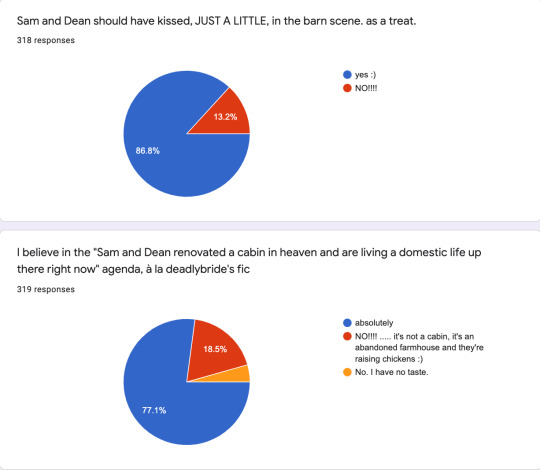
1. Starting off strong.
2. Pleased with this one as well.
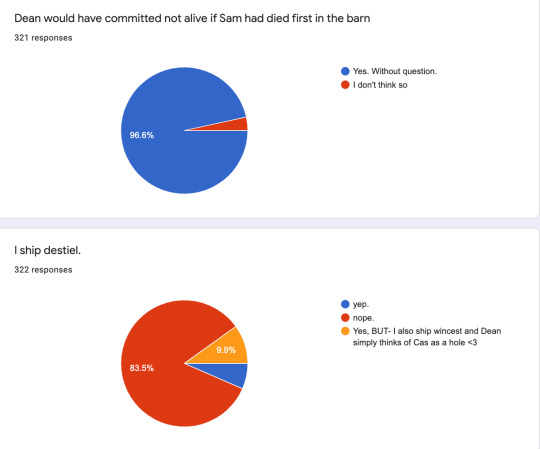
3. Yep, I expected this response from most of us.
4. Sami, I made the wincest and destiel response just for you. YW.

5. CMON YOU GUYS......live a little!!! samjack sexy
6. I’m not really surprised that Playthings got the bulk of votes here, but I think my vote would have been 8x23.
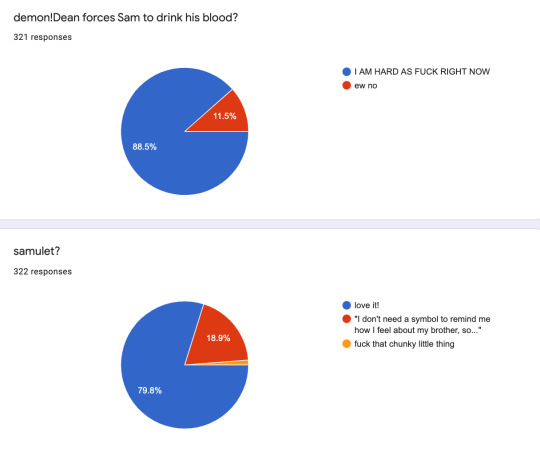
7. :)
8. i’m disappointed that more people didn’t choose the yellow one tbh
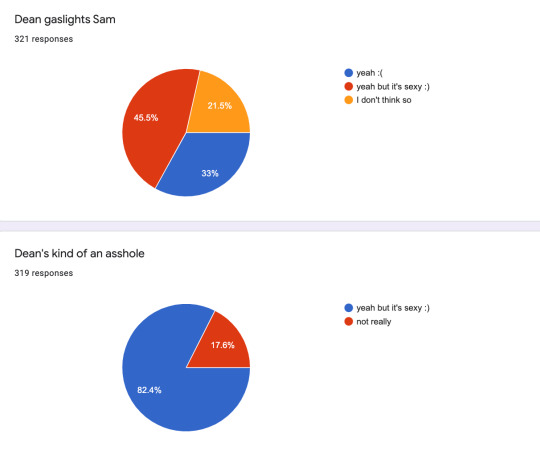
9. it is sexy. it is. wake up.
10. i love Dean, but he’s definitely an asshole. and that’s what makes him a great character!
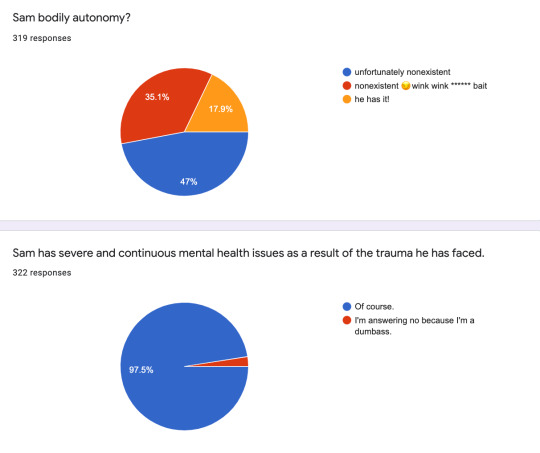
11. hehe.....i understand why not a lot of people picked noncon bait....u r valid its ok im gross.
12. WHO THE FUCK PICKED NO......have you ever consumed media
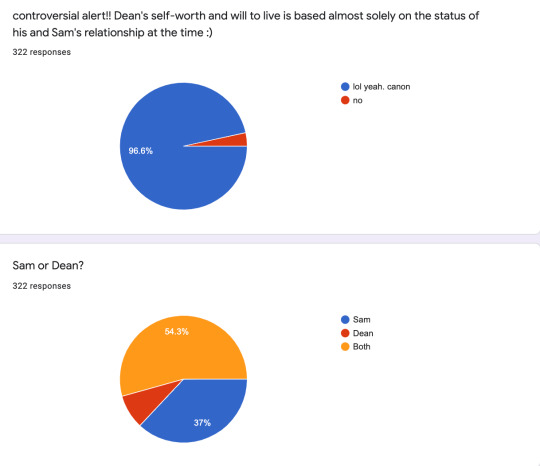
13. WBK.
14. damn, Dean kinda got the short end here! a lot of samgirls took this survey
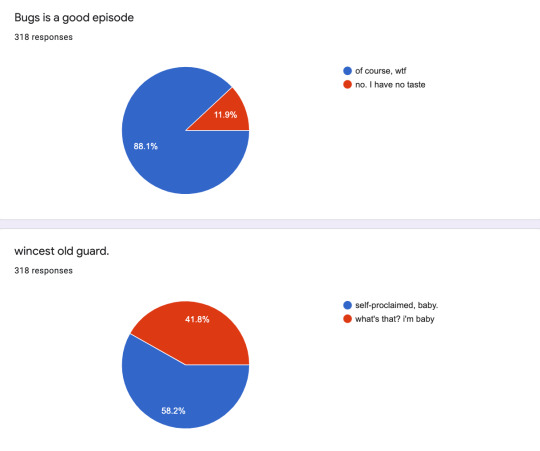
15. i get why you wouldn’t like Bugs bc it does have harmful stereotypes about native ppl but the rest of it is peak season 1 wdymmm
16. almost 50/50 here! old vs new fans we love to see it. I am definitely wincest old guard.
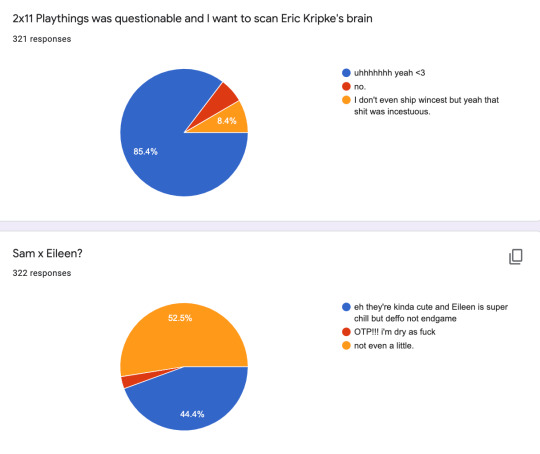
17. YEP. Eric Kripke needs shock therapy for that one
18. The fact that some people admitted to being dry.....tragic. I think Eileen is a great character but they are NOT endgame.
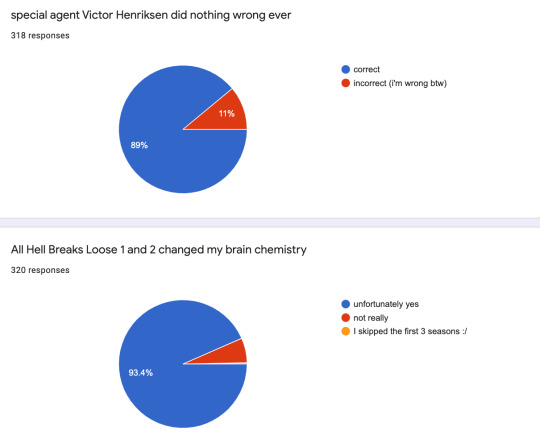
19. SO YOURE JUST GONNA SIT THERE AND ADMIT HOW WRONG YOU ARE??
20. ugh. yeah. same.
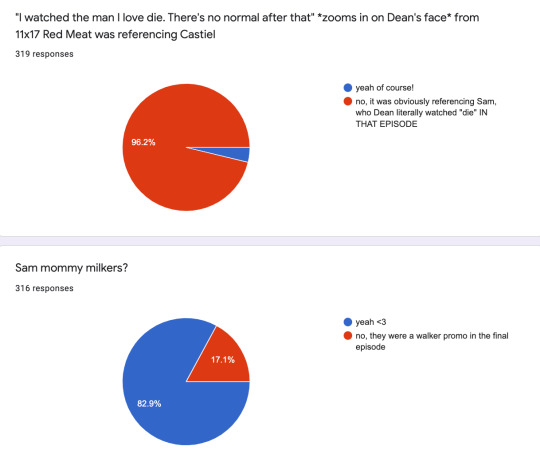
21. who tf picked blue. cmon. red meat incest agenda.
22. SAM MOMMY MILKERS!!!!! hucow sam <3
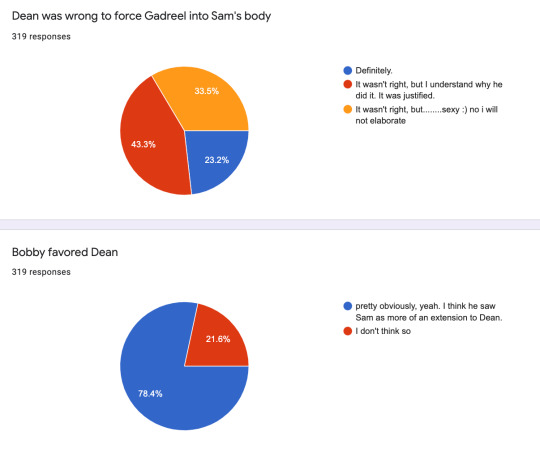
23. Mixed on this one! My response is obviously yellow :)
24. I do think Bobby favored Dean somewhat.
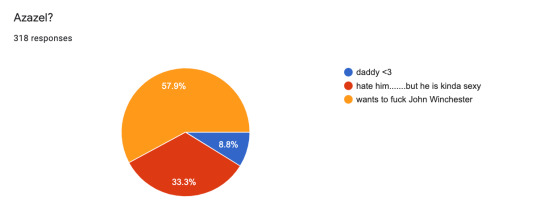
25. Johnzazel agenda so true
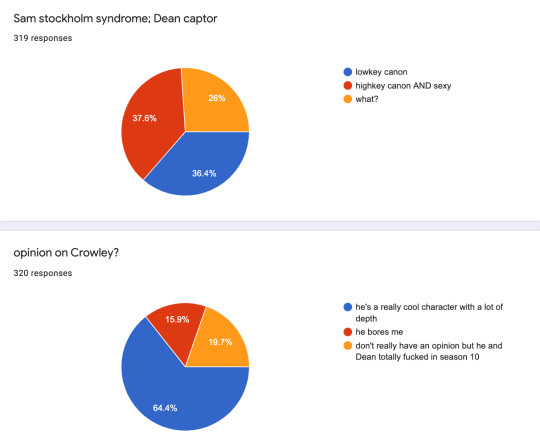
26. HIGHKEY CANON. AND SEXY
27. someone requested a combination of blue and yellow and you’re so right i apologize.

28. mixed on this one for top vs bottom fans! almost a 50/50 split
29. ANNA DID NOTHING WRONG
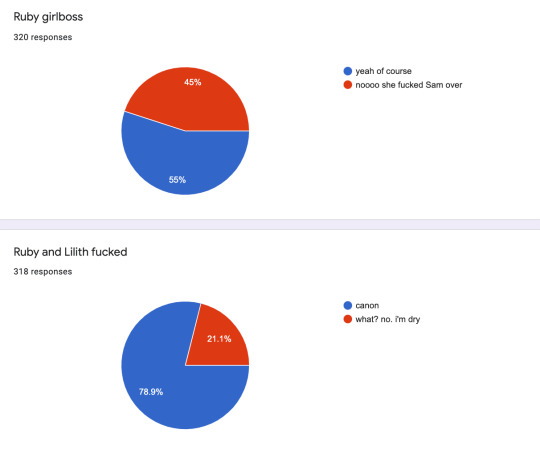
30. I can’t believe this one is almost 50/50. Ruby girlboss you guys are haters
31. again. admitting you’re dry. THEY FUCKED
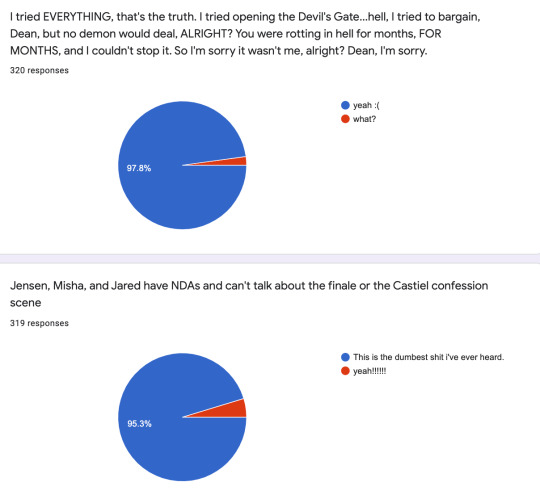
32. yeah :(
33. Q-anon level conspiracy theory.

34. I actually fall into the blue. I do believe Cas was in love with Dean, but not the other way around. I think Cas loving Dean makes wincest so much more spicy
35. I love sam so much
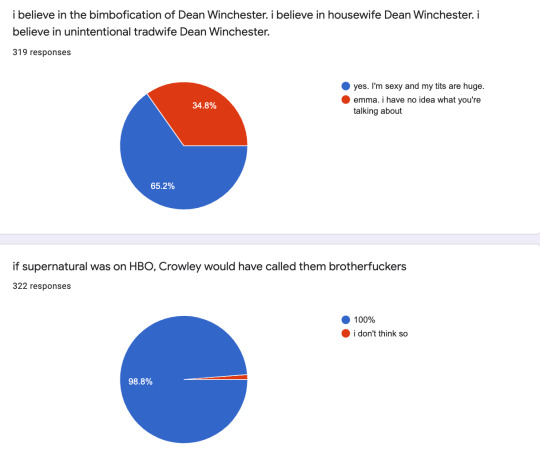
36. those of you who answered yes........join my movement.
37. c’mon. even if you don’t ship wincest you need to admit this one.
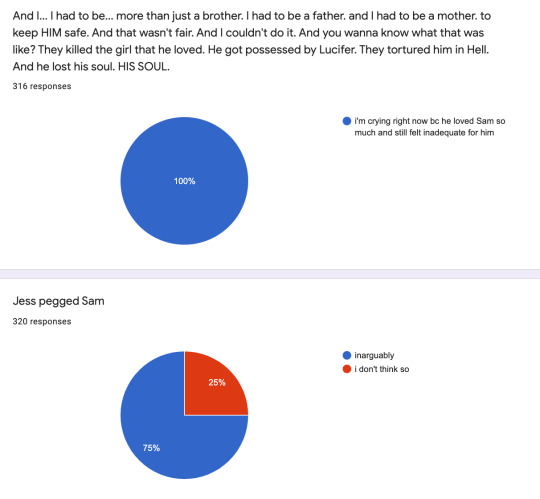
38. sorry this one was self-indulgent.
39. JESS PEGGED SAM.
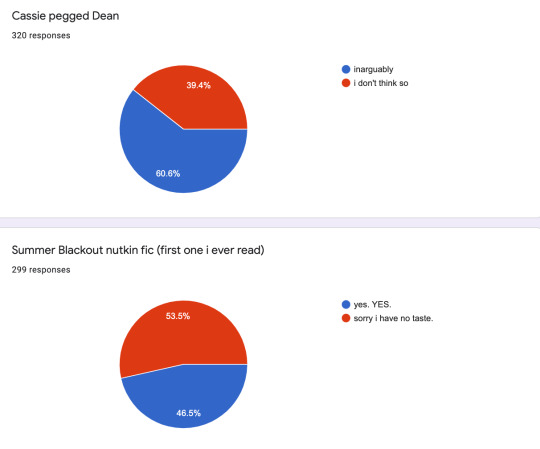
40. idk, i personally think Cassie deffo pegged Dean. She has top energy.
41. So all the people who answered no have definitely not read the fic (were too young to remember it) or are squicked by underage which is ok! its one of those fics i read back in 2010 so i have fond memories of it

42. hahahah you guys were mean on this one
43. it’s canon bro sorry
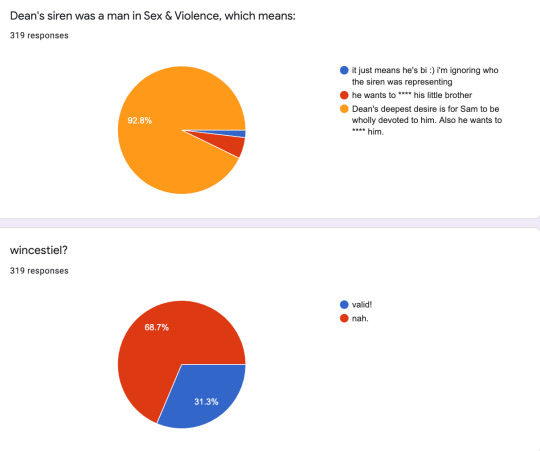
44. thank god this one was majority yellow
45. i give wincestiel a valid pass! dean has multiple holes

46. Jack is hole <3
47. I actually think both are great (and ppl were mad I didn’t have that option srry) but deanpussy is incredible and underrated.
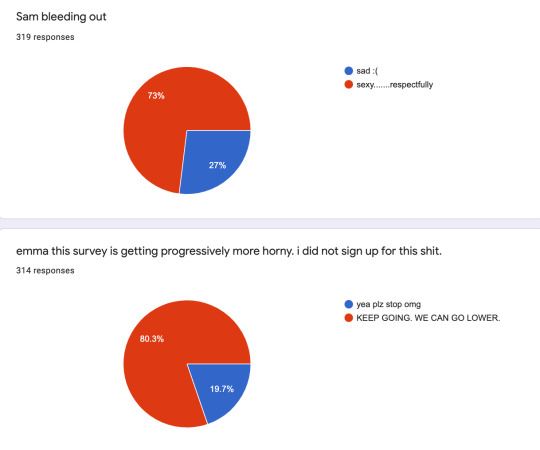
48. SEXY>>>>>>
49. thank you for enabling me.

50. can you guess the redacted part? it was: insert various objects into himself :))))
51. ok heres the big question! i’m not surprised ilysmmbb won, but i personally vote for “yeah, there he is” !! i think its underrated and such a tender moment.
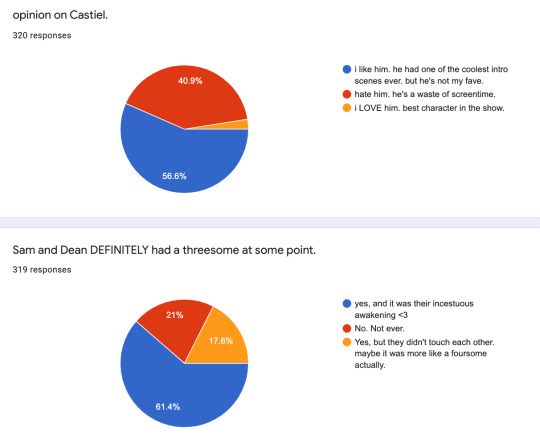
52. i’m in the blue. i like cas.
53. i actually am in the yellow on this one. i think its more realistic, although blue is hot forsure

54. top 3 cas moment right there.
55. objectively yes on this one. thank god for COVID- *gets shot at*
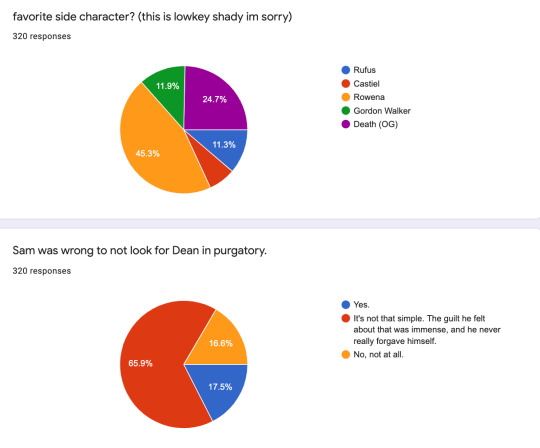
56. sorry this was shady i’m not really like this usually haha. i think death is my fave besides Rowena
57. obviously i’m in the red. i’m shocked that so many people said Yes.......
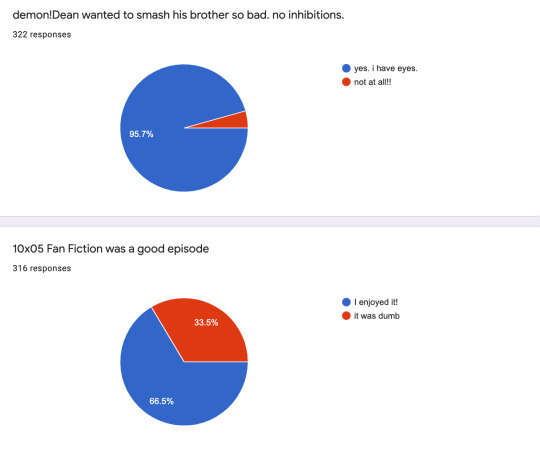
58. Clearly.
59. I enjoyed fan fiction! i love campy episodes as you all know (like Dog Dean afternoon and such) so i loved fan fiction. it was a nice nod to someone like me who has been watching for a long time.
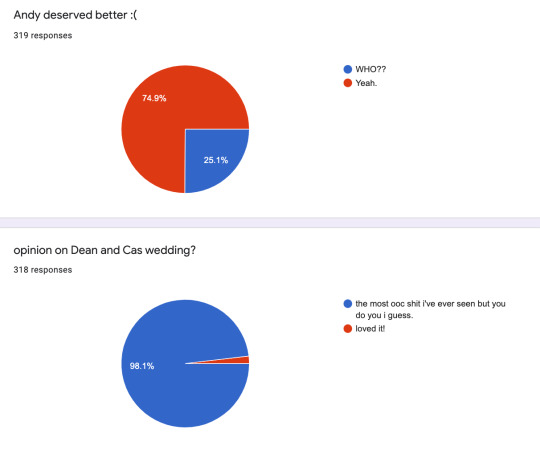
60. HOW THE FUCK COULD YOU NOT KNOW WHO ANDY IS. i wish he would have been in the show longer........
61. uh....yeah.
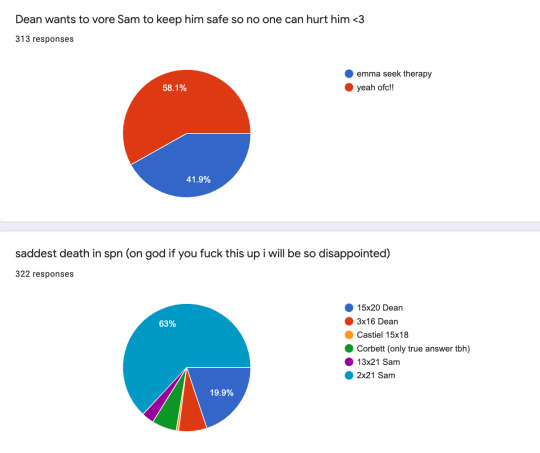
62. Yeah c’mon. Dean would and you know it.
63. Thank god you guys didn’t fuck this up. I would agree, but Corbett is a close second for me.
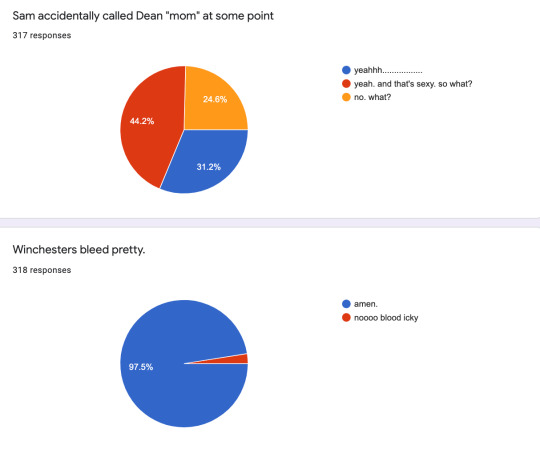
64. IN THE RED BABY!!!!
65. we love a man bleeding out. we do.

66. i actually think misha is chill with J2 but.....you can’t deny J3 have more chemistry.
67. I uh......don’t think Dean would be a great father. is this me projecting my own issues with my father onto Dean? maybe,,,,
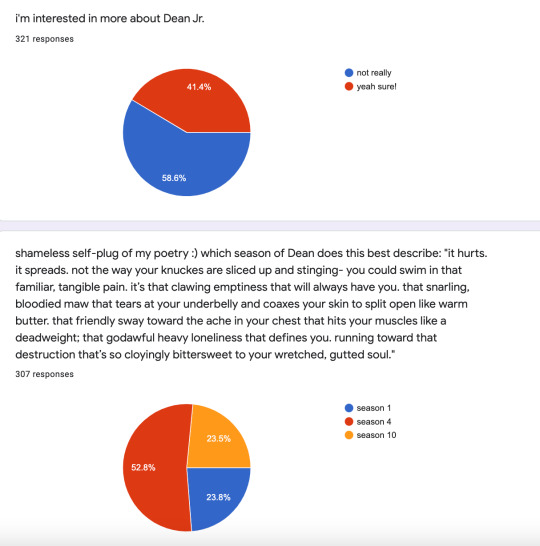
68. i’m surprised this was so negative! I think i would be interested
69. thanks for reading my shitty poetry!! i also had s4 dean in mind when writing this
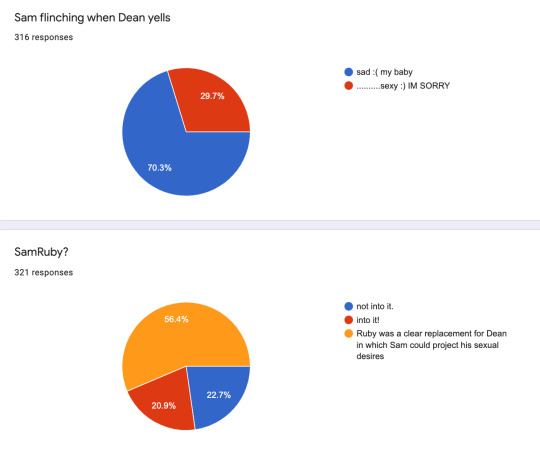
70. CMON.....ITS KINDA SEXY CMON.......that spice of battered wife syndrome.......violent man in the house.......sam beaten down....im barking
71. haha yessss go yellow.
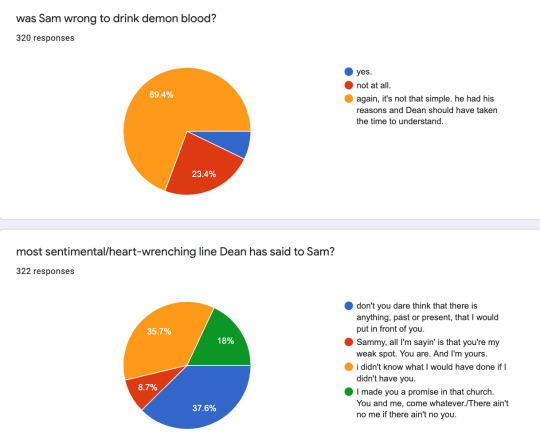
72. go yellow again.
73. I think I would actually vote yellow on this one. what a sweet and beautiful thing to say to someone, and its so very DEAN.
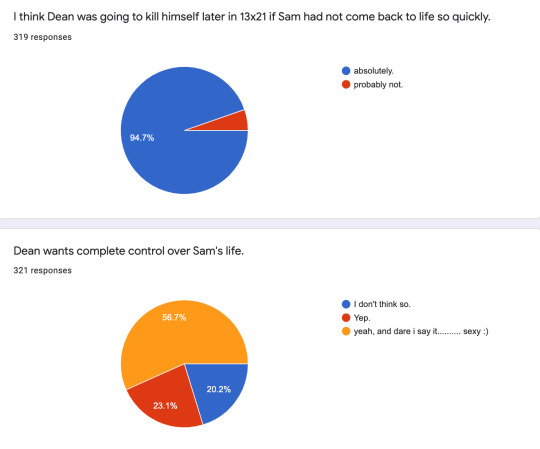
74. mhm. i think so.
75. SEXY CONTROLLING OLDER BROTHER!!!!!
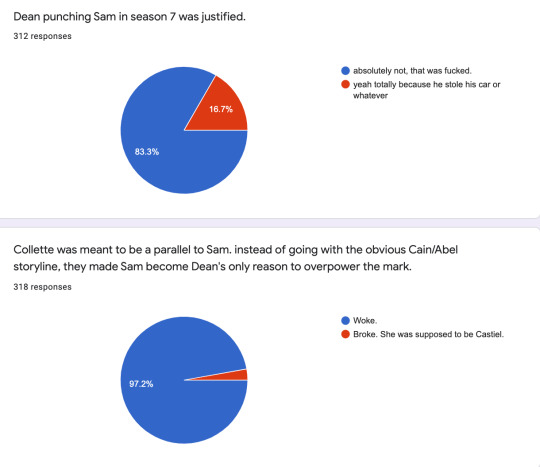
76. no idea why people answered yes to this one. that punch was fucked up. was it sexy? thats another story,,
77. WOKE.
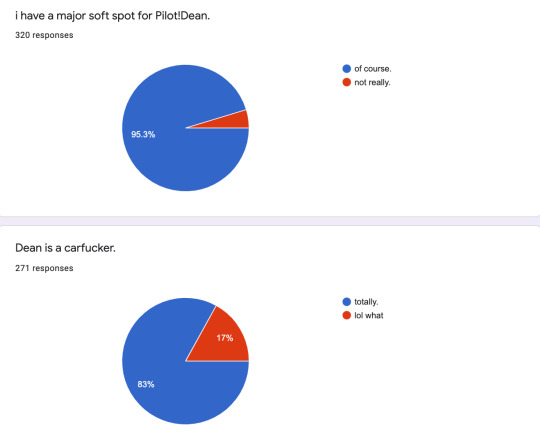
78. I do. I love pilot Dean.
79. Dean is a carfucker. any side of the fandom can recognize that

80. thank you GREEN!!!!!!
81. Sam is bi wtf! Sera Gamble erasure
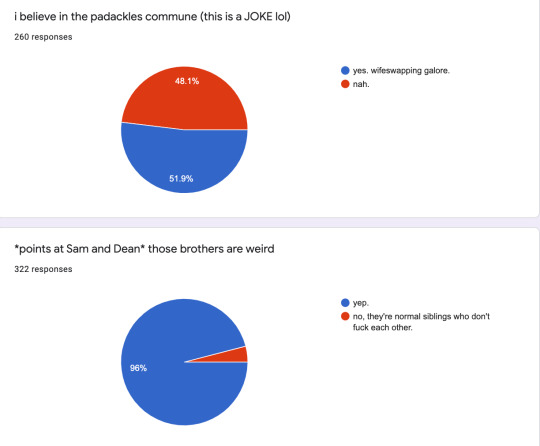
82. Padackles commune <33333 they all fuck and they don’t know whose kid is whose!!!! (not really but this is sexy)
83. THESE BROTHERS ARE WEIRD FOR SURE.
79 notes
·
View notes
Text
alright fuck it
here's a lil story i'm writing. i have no idea where it's heading but i want to share it.
first | next
~~
Stranger
~~
“Do you have a minute?” asks the stranger that has taken a seat next to me. I just wanted to read a book in the park and NOT talk to people. It’s the reason I’m out here, to not talk to people. Well, that, and the fact that my therapist keeps yelling at me to go outside.
“Y-yes?” I said back to him, shutting my book. There it goes, that darn stutter.
“I’ve had a heck of a day. I got laid off from the only thing keeping me from living in my parents' basement, my phone shattered after this stupid kid knocked into me on his bike, I lost this really important family heirloom after my house was robbed by my step-mom, and, I have no friends to vent to, which why I’m talking to you, a stranger. No offense.”
I smiled. “None t-taken. That sounds li-like a pretty crappy d-day to m-me.”
He looked confused. “You…”
“I-i-i-it’s my s-stutter.”
“Oh. I’m Cody by the way.” He said, delivering a warm smile along with a hand to shake.
I shook his hand. “I’m Wil-Wilson. N-nice to me-meet you.”
Here is usually where the people who thought I could be a potential friend go away, but Cody was different. He stayed, asking me what book I was reading, talked about how the economy was failing, new shows on Netflix. Ya know, the usual.
Eventually, he decided that I was good friend material, and we exchanged numbers.
I walked home after Cody left, considering my social interaction bar had been used up for the day talking to him. Cody, the only person who judged me by how I acted instead of my stutter. He was nice, his appearance wasn’t anything out of the usual indicating he wasn’t a serial killer, which was always a perk. He also didn’t show any signs of isolation which is why I was surprised when he told me he didn't have any friends, but everybody copes in their own way, I guess. His tone of voice suggested that he goes to therapy, he sounded very on edge, possibly paranoia, but he did say he had a bad day.
I shook my head in an attempt to clear my thoughts. My CSI training tended to kick in from time to time. I had gotten “let go” from my CSI position at NJPD because of head trauma, also known as, “We don’t want a kid with a broken dream and a stutter solving murders.”
I opened the door to my apartment and stepped inside. Just as I had expected, nothing had happened. My living room was a mess, decorative throw pillows all pilled and smushed. The coffee table had empty coffee mugs littered around its surface leaving white rings on the table. I guess I should clean them up.
After cleaning up the coffee mugs and the white heat rings, I grabbed a cup of water, sat down in front of the TV, and flipped to the news.
As usual, the news delivered nothing but depressing news about how the president’s attempt to do something-or-other was succeeding. Or failing. I never paid attention to the news.
I turned the TV off and decided to go do something productive with my time and then did nothing because who has time for productivity and stared at the ceiling.
Eventually, my body started telling me I needed to sleep and listening to it, I changed into my sleepwear and went to bed.
I woke up to birds chirping and the sun shining through my bedroom window, which would lead you to think I would have a wonderful day, meet someone new, maybe go shopping for supplies to make a delicious meal, but no. My plan for the day was to update my laptop, watch some TV, then maybe mow the lawn.
While I was staring at the black screen of my updating laptop, my phone vibrated signaling a text message had come through. Getting text messages was not a usual occurrence for me. I only ever got messages from my data plan telling me I ran out of data. I looked down at my phone and to my surprise, it was Cody asking if I wanted to hang out today. After proofreading my response and then proofreading it again, I sent it to him.
Waiting for his response, I sat on my bed chewing my nails.
What if he isn’t really your friend, he’s just pretending to be?
What if it’s all a joke and he hates you?
No, stop that.
Why would anybody want to be friends with you?
You can’t even speak right.
Stop.
Nobody even likes you.
That’s it.
I got up and got changed, avoiding looking in any mirrors. My outfit wasn’t anything extraordinary, a pair of jeans with an old band t-shirt and leather jacket matched with Converse. Without waiting for a meeting place from Cody, I headed out the door, slinging my beige satchel over my shoulder. In my satchel was my phone, my wallet, a pocket knife and a lighter.
I arrived at the park searching for Cody: vitiligo, blonde hair, freckles, blue eyes, glasses, a pretty good sense of style. Judging by what he wore yesterday which was a pair of work pants, a long-sleeved light pink dress shirt, and a navy blue tie, he would wear something casual like jeans and a sweatshirt. What he wore yesterday was obviously his work clothes but as he said, he had gotten laid off from his job so he wouldn’t be wearing work clothes.
I had actually done research on jobs for him based on the personality gathered from him. I know, I know. I’m weird because somehow I know his entire personality after just meeting him for the first time. Yeah well, I don’t care. The job turnouts were nice, things along the lines of psychiatrists, therapists. Ya know, socially demanding jobs. Something I could never do.
Eventually, I found Cody at a coffee shop talking to the lady at the counter about how she should go see a therapist to cope with the loss of her husband. What a gentleman.
He turned around to find a seat in the crowded coffee shop and noticed me standing in the middle of the shop, staring at him like a loser.
“Wilson, you found me!” He said, walking up to me as if he had known me longer than a quick chat on a bench.
“I did,” I said, nervous that other people would see. “Now le-let’s go,” I said, grabbing his arm and dragging him to the door.
“Don’t you want anything?” He said, struggling not to spill his coffee.
“No, I’ll p-pick up a Mo-Monster on the w-way to the ma-mall,” I said.
Realizing I was basically holding Cody’s hand, I let go and turned to face him.
“S-sorry,” I said, turning a slight shade of pink.
Cody situated himself. “About what?”
“Nevermi-mind,” I shook my head as if doing that would remove the awkwardness from the situation.
Cody kind of smiled. “Okay. So, we’re we headed?”
“I was th-thinking the mall, m-maybe hit up H-Hot Topic,” I said as I started to walk down the trail.
The trail at the park was an absolute must if you’re a tourist. In the fall, the trail became covered in amber-gold leaves. Animals of all sorts rustled the leaves, burrowing to make their homes. Grumpy park keepers raking leaves into piles only to have children jump in them and ruin them. God, I love it.
“Sure. Doesn’t the mall have a food court? We could stop there and get something to eat.”
I turned to look at him. “Th-that would be g-great.”
We walked in silence to the mall. I could never quite figure out Cody’s shopping preference. He looked like he shopped at Kohls or Sears. Some relatively nice places. Maybe Boscovs. I, on the other hand, shop at places like Hot Topic and Journeys.
We arrived at the mall and made a direct line to a Hot Topic. I could tell Cody had never entered a Hot Topic in his life, considering the fact he scrunched up when he saw the cashier.
I walked up beside him and nudged him. “This your fi-first time?”
He took a sip of his coffee. “In a Hot Topic, yes.”
I turned back to the t-shirts. “I can te-tell.”
We browsed the store, Cody striking some conversation with other shop goers. How is he so social? He even got the kids in Hot Topic to talk to him.
“Wilson, c’mere!” Cody yelled from the other side of the store. The entire store, which consisted of like, 3 people, turned to look at me.
I chuckled awkwardly. “Uh, h-h-hi.” I gave a tiny socially awkward wave which was responded with an understanding nod from some kid in a Panic! At the Disco shirt.
I scurried over to the other side of the store. “Wha-what do you wa-want!” I hissed at him.
Cody gestured over to the shirt he had in his right hand. “Don’t you like this band? I saw them on your lockscreen.”
He was holding a Twenty One Pilots shirt that had the words: “I belive in Josh Dun” etched around the alien-like symbol that represented Josh Dun. The shirt wasn’t really my style, but Cody looked so proud of himself for finding a shirt that I could possibly like, that I couldn’t turn it down. I grabbed the sirt from his hands and slung it over my shoulder. I looked for other t-shirts, failed, and ended up in the pin section. A sign underneath the bucket read, “Buy 2 get 1 free”. I was always a sucker for deals.
“Watcha doing?” A voice was accompanied by a brush on my shoulder. I suspected that it was Cody’s arm, because his hand brushed against mine. As if that same hand had taken a paintbrush, my face was painted a light red. Well, more of a light pink. For some reason, Cody’s touch made my chest feel all weird, my stomach flutter, and my face heat up. Of course I knew what this feeling was, I’m not stupid.
“Uh, I’m l-looking for pi-pins. They’re b-buy two get one fr-free.” I said.
Cody was immediately intrigued. He rummaged through the pins, discarding ones he didn’t like. I already held two pins in my hand, a Fall Out Boy one and a subtle LGBTQ+ Pride pin.
Now, Cody wasn’t the type of person I would have thought to have also picked out an LGBTQ+ Pride pin as well, but here we are, Cody with an extremely flamboyant Pride pin in the palm of his hand.
My face tuned a medium shade of red. Holy crap, Cody’s gay. I mean, it didn’t bother me, obviously, but you never would have guessed it.
Somehow, I completed the transaction between the cashier and I, and me and Cody made a beeline for the Five Guys. Five Guys was a restaurant I had come to many times when I was a kid. I ordered what I usually got, a Veggie Sandwich. Cody ordered a Cheeseburger with Small Fries. An order I can respect. We searched for a place to sit before choosing a seat underneath the trees they put in the mall. It never occured to me why they put trees in the mall until now.
Seeing Cody smile at me from underneath the trees, a stray ray of sunlight shone through his glasses and making its way to his blue eyes, his smile making me feel warm inside. God, what I would do to take a picture of him right now.
“H-hey, can I t-take a p-p-picture of y-you, Cody?” I said, pulling my phone out of my pocket.
“Sure. Where do you want me to look?” He said. I was honestly surprised by his reaction. He didn’t think I was weird or refuse.
I adjusted my phone camera to the light settings. “J-just look directly a-at the c-cam-camera and smi-smile.”
He did as I said, smiling directly at the camera. The shot was super cliche, but he looked great.
I took the picture, ignoring weird looks from other customers, and sent it to Cody. The picture came out nice.
“Put a black and white filter on it.” Cody’s voice sounded from my shoulder. His chin rested right where my shoulder met my neck.
I put the black and white filter on it. The ray of sunlight that passed diagnally on his face was turned to a light gray.
“But it l-look-looks better with col-colour.” I said, changing it back.
Cody stared at it for a few moments, his face looked rather studious, as if he wanted to remember every aspect of the photo.
“Yeah, your right. Keep it coloured.”
I smiled. “I’m al-always ri-right.”
Something about how quickly our friendship had formed made an impact on me. We met on a bench yesterday and now I’m sending him a picture I took of him in a mall plainly because I wanted to. Something wasn’t right; friendships don’t move this quickly. People weren’t just nice. As depressing as it sounds, it’s true. People aren’t nice with no reason. We’d love them to be, but they just aren’t.
Cody threw away the remains of his lunch and sat back down in front of me.
“So, want do you want to do now?” He said.
I shrugged. “I do-don’t know. May-maybe we c-could go to-”
Cody gasped. “What about a play! There’s a theatre down the street, and the admission’s free!”
I smiled. I friggin’ love plays. Especially musicals. Something about how people can change their person to a completely different personality always made me happy.
“I lo-love the sound of th-that.” I said, standing up and throwing the remains of my veggie sandwich in the garbage can.
We left the mall in a hurry, rushing to hail a cab to the nearest theatre. We both sat in the back of the cab as the driver drove us to our location.
“So, do y-you know wha-what play it i-i-is?” I asked.
Cody shook his head no. “Honestly, I don’t really care what play it is. I just love the acting behind it.” He said.
“Me t-too. I just lo-love how the pe-pe-people on st-stage can tra-transform into wha-whatever chara-character they ne-need to-” I was cut off by the cab driver.
“Ay kid, could ya knock it off with that stutter? It’s really annoyin’ and it’s gettin’ on my nerves.” He said. He had a heavy jersey accent, a contrast to our current location of New York.
“Yes s-sir.” I said, folding my hands in my lap and drawing my eyes to my feet.
Cody kept looking between me and the cab driver. “What? No.” He said, knocking on the glass that divided the passengers and the driver.
“Sir, can you pull over?” He said. His tone sounded like a mother who was about to scold her child.
The cab driver groaned and pulled over.
“What?” He said, twisting his body so he could see through the little window.
“My friend can’t help his stutter, okay? And for you to ask him to ‘knock it off’ was extremely impolite.” Cody said.
‘Friend’. I held back my smile.
The cab driver snorted. “I don’t care if he can help it or not, it’s annoying and it distracts me from driving.”
Cody laughed in disbelief. “Oh, I see. Well, in that case, can you stop talking in that obnoxious jersey accent of yours? It distracts me from enjoying the view. And, maybe stop smelling like rotten fries because it makes it hard to focus. And I would heavily enjoy it if you threw out that black ice smelly tree, because all it does is combine with the scent of feces back here and makes it smell worse.” He smiled sweetly. “Thanks so much, mmm-bye.”
He opened the cab door and walked over to the sidewalk to open mine. I got out, throwing a dirty look at the cab driver. We left without paying.
“Hey, th-thanks for standing u-u-up for me b-back there. It rea-really meant a lo-lot.” I said.
Cody smiled. “No problem! It just pisses me off when people are mean to others.”
We walked to the theatre. Cody was right, the admission was free and it was one of my favourite plays. Romeo and Juliet.
Cody and I walked up to the admission box, standing rather close to each other.
“One ticket for me and one for my friend.” He said.
There it was. That word Friend. Now that I think of if, I haven’t really had a friend before. Yeah, I know. You’re probably thinking ‘Wilson, I bet you had at least one friend.’ Nope. None of the kids in elementary school talked to me enough for me to develop a friendship with them, and middle school was, well, middle school, and after my accident in high school, no one spoke to me straight up. I’m honestly surprised I have the social skills I have.
We walked down the aisle and found our seats. We were seated in the 3rd row of the middle section. So right near the front.
“Have you ever seen Romeo and Juliet?” Cody asked.
I raised my eyebrows. “Have I ev-ever seen R-Romeo and Juli-Juliet?”
Cody smiled. “I take it you have. Well good, because I’ve never seen it.”
“Really?” I said. How?????
Cody shook his head. “Nope. Never seen it.”
I sighed. “Do you at le-least know th-the p-plot?”
“More or less. I know theres a thing with a balcony?”
“Yes.”
“And they,” He looked side to side, checking for people. “Both die?”
I smiled and nodded. “Y-Yes! So you kno-know the basic-ics. G-Good.”
We turned our attention to the stage as the lights dimmed.
yea that's it so far. ask me if you wanna be tagged!
17 notes
·
View notes
Text

Doctor Who Meta: Cyberium AI Meta Masterpost
@grassangel said: A thought for you because of your meta: the Cyberium as the fluid in the opening credits.
It definitely does have a resemblance, doesn’t it. And that fits in with the Chibs style of ‘if you think it’s odd/wrong it probably serves a bigger purpose’.
The Cyberium AI is weird as hell. It’s clearly really important, not just as a plot device, but as itself. It’s got characterisation. It’s got a mirror important enough to be in the first episode - Tzim-Sha’s Gathering Coil, the first thing this Doctor ever faces.
And it mirrors the Doctor and Timeless Child’s ‘Power’. I mean it really mirrors them. To the point where, like with the Lone Cyberman and Rassilon, I’m not sure if it’s mirroring the character ridiculously heavily, or if it just straight up is the character. Just like working out Clara was going to be the Doctor with a TARDIS - I knew the result but I didn’t know what form it would take, literally the character or not, until the end. Cus that’s Doctor Who and its shapeshifting for you.
You know how my preferred method is to just point out all the metas as I see them, so you can draw your own conclusions if they’re different to mine, but I will actually put my thoughts as to what this all means at the end.
So click below for every bit of Cyberium AI meta from not just Series 12, not even just Series 11...but all the way back to Season 25)
(Under a cut because there was so much more than I thought there was)
In episode order then:
The Woman Who Fell To Earth
(The Gathering Coil as double-layer, mirroring the Cyberium AI’s role itself; but also therefore as its Doctor character mirror, and Timeless Child ‘Power’ mirror)
-See the title of the episode. The title with at least three references now.
-It crashes into a train when we meet it. A few moments before the Doctor does.
-“What are you? Okay, you don't like questions. More the private type, I get that.”
-Its data is absorbed into the Rassilon-mirror Tzim-Sha.
-In doing so also implants into him - and I quote the Doctor - “Micro-implants which code to your DNA. On detonation, they disrupt the foundation of your genetic code, melting your DNA.” Sound familiar?
-It’s being used - against the laws of the user’s species - in order to attain leadership. (Like Rassilon/Tecteun)
-Looks like one creature but is actually a huge number in the appearance of one. (The Doctor).
-The Gathering Coil might look like an Eldritch horror, but it never actually kills anyone on purpose. When it first shows up, the woman driving the train dies from shock, (“Shock” get it? Like...) Grace dies in an attempt to stop it by electrocuting it. The most damage it itself deliberately does, is short-circuit a crane.
----
The Haunting Of Villa Diodatti:
(Heavily as Timeless Child ‘Power’ mirror(?))
-The Lone Cyberman confirms the Cyberium AI to be both a lifeform and ‘weapon of some kind’. Like the Ux.
-We meet it already inside Doctor-mirror Percy Shelley - suicidal, social activist, and a great believer in the importance of society having Hope even if not so good at it himself. He is not trying to use its powers, but as Guardian of them doesn’t want others to take and abuse them. The word ‘Guard’ is also used by Mary in regards to the child. (And we could leave this episode and say how Irish Metaphor Doctor was a ‘Garda’ but you get the point).
-It hides in a house that appears to warp and change and shield and use a perception filter - theorised to be the Cyberium AI warping the perceptions of people in the building, even though none of them are remotely Cyber in any way. Shelley says directly only some of the changing is his doing. On a practical level, it must have strong telepathic abilities - like the Doctor. On a meta level, it hides itself in a place that mirrors a TARDIS.
-The Doctor can’t find it at first because it’s “hidden away, cloaked, too big to register.” Like the Timeless Child memories.
-The Doctor seemingly genuinely didn’t know what it was a minute ago, when she was asking Ashad what it was. But now suddenly she does know: “Cyber technology. The knowledge of the whole cyber race and AI from the future, containing the knowledge and future history of all Cybermen”. Almost as if she’s remembered.
-This next bit’s important and connected so we’ll just do the whole lot and break it up afterwards:
Percy: “They scorched and split the sky. Built the army of all armies. Left behind only pain, rage, fear and death.” Mary: “How is he seeing all this?” The Doctor: “The Cyberium is burning through his mind. It'll destroy him if it stays in him much longer. An epic battle. The Cyberium at the heart of it, controlling data, strategy, decision-making. Clever! Very clever. Someone took it from the Cybermen, sent it back through time here in an attempt to change the future.” *The Lone Cyberman tries to break in* The Doctor: “In an attempt to protect you from that.”
-Like Donna with the Doctor’s memories, this is burning Percy up. -An epic Battle, like with the Ux - a great battle referenced and not explained. The Cyberium AI instead of the Ux at the heart of it, used to fight it. (If anyone’s still assuming the Timeless Child(ren) thing was simply about regeneration power, there should be more focus on the Division and the Child as weapon). -The Doctor again coming in with extra information. -Possible Future Meta: Someone attempted to change the future by taking the source of power from the Rassilon (see the mirror).
-Thirteen tells the Doctor-mirror to just let the Rassilon-mirror have the power. (Reminds me of how the Timeless Child ‘would not yield any secrets’). But the Cyberium AI has been sending Shelley (Doctor-mirror) symbols and numbers. So Possible Future Meta: It wasn’t just the regeneration power Rassilon got from the Timeless Child, it was also information. (Of course - the Doctor, especially this one meant to mirror all this, is the Builder And Destroyer, after all)
-We confirm the Cyberium AI’s own sentience, separate from its host, (and its reluctance to leave). It changes the mental map of the house specifically to avoid the Lone Cyberman.
-The Lone Cyberman believes the host must be killed in order to get the power out. Mary Shelley immediately talks to the Lone Cyberman about fatherhood, and how he doesn’t want to do this. (Rassilon/Tecteun)
-The Doctor convinces the Cyberium AI to leave by showing it Percy’s future. (The mercury-like substance exits Percy quite like the poison with Ten. Given the amount of Ten-era-mirroring, this one’s cute). (Possible Future Meta: The Doctor meeting Timeless Child self, like with Martin!Doctor).
-The Cyberium AI goes to the Doctor, who calls herself its “true Guardian”. Says it feels “Very at home”. Going with how she seemed to remember what it was without ever being told earlier...
-The Doctor, when her friends and the planet is at risk, decides to give it over the the Lone Cyberman, and the Cyberium works with her in a way it refused to with Shelley, meaning she didn’t need to die, even though she says it had already started fusing.
-Next after the Doctor-mirror/Doctor, the power enters the Rassilon-mirror.
-(Yaz restarts the Doctor-mirror’s heart. That’s not important to this meta, but it sure is important to other ones).
-We talk about ghosts just as we enter the Ghost Monument.
----
Ascension Of The Cybermen:
(Both as Doctor mirror and Timeless Child Power mirror)
-Cyberium!Ashad says “The Cyberium does know you. Both you and humanity will be destroyed, and I shall bring the Cyber race to its greatest ever glory.” - the Cyberium AI has already seen the Doctor’s death before. Or it’s lying.
-The Doctor’s blatantly obvious talking-to-herself therapy speech is to Cyberium!Ashad.
“The Cyberium has given me understanding. It has distilled my purpose. I am the perfect vessel.” - A container, a ship for the Cyberium AI.
“Everything is in me for the ascension of the Cybermen, and beyond. ... All your deaths. The death of everything is within me.” - First, mirrors the ‘life’ within the Timeless Child. Second, considering before this was previously an AI trying to avoid conflict and entering Ashad, the fact that Ashad and his death particle gets convinced to go to the Master and Gallifrey, makes me wonder how much the Cyberium AI was forced to go along because that’s its nature and it has to follow instructions, or whether it was planning and pulling the strings. Or both - TARDIS-style.
----
The Timeless Children:
(Heavily as Doctor mirror, minorly Timeless Child Power mirror)
-“Oh. Oop. Excuse me. Check my notifications. Oh, goodie! The Cybermen are here, at the Boundary. Better extend the hand of friendship. Breaker 1-2 calling all Cybes.” So the Master knew that the Cybermen would come. How? They haven’t interacted from our perspective at all.
-The Master says to Cyberium!Ashad “I want you to think of me as your new best friend.”
-Master to the Doctor: “Don't heckle, dear. I can always decide to cut you short.” -Master to Cyberium!Ashad: “Oh, shoot. I should've said, somebody needs to cut you down to size, then zapped you. I was just trigger-happy. I'll use it next time.” (Plus, a ‘next time’ - we haven’t seen the last of him).
-The Cyberium AI is revealed to have been the one to create the Death Particle. Which again makes me question who’s pulling whose strings. As the Master points out Ashad is more organic than most, and Ashad simply says that he’ll mechanise when the process is over - ignoring the point that this didn’t work before. And Ashad seems to think it will wipe out everything, ignoring the reality that its coverage is only a single planet.
-The Master is clearly talking to the Cyberium more than Ashad at points.
Ashad: “The Cyberium will process and dictate the strategy.” The Master: “The Cyberium. I've heard a lot about that over the millennia. The heart of all your power. The centre of all Cyber knowledge.” -Sounds very like the other Timeless Child(ren) mirror - the Ux.
-The Master actively flirts with it. “Oh, come on, Cyberium, show us some leg. What do you actually look like, hmm?” And after shrinking Ashad without so much as a close-up, like he’s been nothing to the plot, “Well, aren't you pretty? And fast. You made your exit very swiftly there. Worried, were you?”
-The Master hoped the Death Particle would activate and laments to the Cyberium AI that his “nice little gamble” didn’t pay off - as in it didn’t kill him. (Assuming Timeless Children plural, that may be the only thing that would work, and that he is telling this to the Cyberium AI again could fit nicely with the narrative idea that it knows what it’s doing).
-“Oh, sorry, were you close? Candidly, I think you can do better.” ... “Wow, that was quick. Wa-ha-ha! Whoa! Woohoo! At least buy me... dinner!” - (And considering we all had a giggle at the clearly intentionally funny ‘a piece of you is in me’ line that’s going to happen either in about a minute, or in the world of the episode and making adjustments for simultaneous storytelling, right now...)
-“I ransacked the Matrix of the Time Lords, distilled all the knowledge, all the experiences, all the discoveries, into these brains up here. All the Cyber knowledge, all the Time Lord knowledge. Put it together, what do you get? Absolute supremacy in the universe. Choose me.” - (The Master pointing out we’ve now got two sets of incredible knowledge. Rule of three has me wondering about the Timeless Child���s ‘Knowledge’.)
-After the power was originally in the Doctor-mirror/Doctor, it then went to the Rassilon-mirror(?) and then to the Master. If you’re a fan of Timeless Children Plural theory.
-The Master: “No, Doctor. As of now, I wish my enemies a long and healthy life, so they may witness my many triumphs, because they will be legion.” - (So, in case you’re not familiar with the Legion thing, two points: A Legion was a division in the Roman army of about 3000-6000 men. We will be coming back to Rome - oh God will we - but just slot that information away for later. Point two - For another use of Legion, we need to head to the Bible, Mark 5:1-9. ‘Who cares, Rowan?’ Well, this is the story in which there is a man living among tombs, who no-one can bind, not even with chains. He cries out and attacks himself, and on seeing Jesus in the distance rushes over and kneels before him, screaming that he’d put him under oath not to torment him. Jesus doesn’t talk to him, but to what is possessing him, ordering it to come out, and asking its name. And it, not the man replies: “I am Legion, for we are many.” (Fun fact, we eventually get rid of the demons by exorcising them into animals who then run off...a...cliff. *sighs* Ok.)
The Doctor: “You're looking peaky.” The Master: “Oh, yeah. The Cyberium lives in me now, Doctor. Yeah. Yes. See, I've been looking forward to seeing your face about that. I can feel it flowing around in me. The information, the strategy, the... the... the consciousness. It's a beautiful thing. And look at us. I have broken you and created a new race. And now? Now I shall conquer... everything. Oh.”
-“See, I've been looking forward to seeing your face about that.” - This is a quiet point that exemplifies a major one. The Master’s story is different to ours. He knows things that we do not. The Doctor in theory (though I doubt in practice) had never come across the Cyberium AI before, she hasn’t mentioned its name or anything about it to the Master. In theory (again press x) the Lone Cyberman carrying the Cyberium AI just turned up when the Master dragged the Doctor through to Gallifrey as pure happenstance, he should know nothing about that incident with the AI and Shelley (and yet he quotes him). Why has he been looking forward to seeing her face in regards to that? What does he know about it that he expects her to remember? Just like with the Timeless Child infodump, we are fools if we take all this at face value, because the Master planned for all of this. And it seems like the Cyberium AI _itself_ is planning too.
Ko Sharmus: “You didn't start this. I did. I was part of a resistance unit that sent the Cyberium back through time and space. Though obviously we didn't send it back far enough. So this is my penance. Mine to finish. My journey ends here. But the universe still needs you, so I suggest you run.” (Ko Sharmus is treated way too important. We’ve got to see him again.)
----
Done? Done.
Well no, no actually we’re not. Because there is one final episode.
But we have to go back, just a little bit, to the Seventh Doctor. Stick with me. I promise you’ll be glad you did.
Silver Nemesis:
-A story revolving around a thing called Validium.
-To quote the TARDIS Wiki: “It was living metal that could think for itself and was capable of speech as well. When destroyed, it could reform itself.”
The Doctor: “Validium was created as the ultimate defence for Gallifrey, back in early times.” Ace: “Created by Omega?” The Doctor: “Yes.” Ace: “And?” The Doctor: “Rassilon.” Ace: “And?” The Doctor: “And none of it should have left Gallifrey. But, as always with these things, some of it did.”
-Catch that hint of the Cartmel Masterplan where it’s clearly meant to lead you to ‘And? The Other One’. It’s ok, you’re not reading too far into it, I promise.
-“It should never have left Gallifrey, but some of it did. A piece of validium fell to Earth and was found by the Lady Peinforte.” Can you guess what she did with it? Why, she moulded it into a statue of herself.
-A silver lady statue.
-(You remember how we just seemed to abandon Barton? Who is somewhat not human? Was involved with creatures from another dimension? And that statue? Seemed set-up for a cyber plan? Saw nothing wrong with a bit of familial murder? Ooh hoo. Welp.)
-Nazis are involved. Ill-timed notifications. The Doctor forgetting. A cellar. (A fez). A meteorite containing the validium crashes by a barn. On November the 23rd. Happy Birthday. We blow things up. A lot of things.
-The villains of the piece? Besides the nazis and the Time(travelling) Lady? Well it could only be the Cybermen. A bit of the Validium is held by each of them
-The Cybermen take their bit of the Validium to the tomb of the Lady, with an inscription “Death Is But A Door”. The Lady is not buried there, and it doubles as a pun, with a hidden door.
-One of the lead nazis betrays his fellow to be turned into a Cyberman. “Supermen are all very well, but the giants are the master race.”
-The Seventh Doctor is mirrored with the Lady, who describes herself as evil. They even have mirrored scenes with their equivalent companions.
-The Lady: “All power, all power past, present and future, shall be mine. Why, I shall be mistress of all of that is, all that shall be, all that ever was. Yes, all! All!” - Oh, doesn’t she sound familiar now...
-Point Of Interest: Like many of the concepts Chibs has been playing with from Classic Who - the Morbius Doctors, almost certainly the Valeyard - this was apparently a fairly controversial episode among the old guard. Why? Because well...
The Validium: “I am beautiful, am I not?” Ace: “Yes. You're very beautiful.” The Validium: “It is only my present form. I have had others which would horrify you. I shall have those again. You are surprised I speak?” Ace: “I know you're living metal.” The Validium: “I am whatever I am made to be. This time Lady Peinforte called me Nemesis, so I am retribution.”
-I mean this is all cute but it doesn’t explain why it’s here and-
The Validium: “And I'm to destroy the entire Cyberfleet?” The Doctor: “Forever.” The Validium: “And then?” The Doctor: “Reform.” The Validium: “You might need me in the future, then?” The Doctor: “I hope not.” The Validium: “That is what you said before.” The Doctor: “Enough.” The Validium: “And after this, will I have my freedom?” The Doctor: “Not yet.” The Validium: “When?” The Doctor: “I told you when.” The Doctor: “Things are still imperfect.”
-Oh well that’s...Hmm.
Lady Peinforte: “You are nothing. Only the Doctor matters, and he is but a pawn in the game of my making.” ... Ace: “The Doctor's not just going to give you the bow. Tell her, Doctor. Tell her.” Lady Peinforte: “Doctor who? Have you never wondered where he came from, who he is?” Ace: “Nobody knows who the Doctor is.” Lady Peinforte: “Except me.” Ace: “How?” Lady Peinforte: “The statue told me.” Ace: “All right, so what does it matter? He's a Time Lord, I know that.” Lady Peinforte: “Well, Doctor?” The Doctor: “If I give you the bow,” Lady Peinforte: “Your power becomes mine, but your secrets remain your own.” ... Lady Peinforte: “I shall tell them of Gallifrey, tell them of the old time, the time of chaos.” ... The Doctor: “You had the right game, but the wrong pawn. Check.”
-What used to be the Cartmell Master plan is now the Timeless Child Master...plan- Is this why it’s involving the Master? For a pun? Whatever, either way the Seventh Doctor is now a treasure trove of useful ideas - I did wonder why Chibs chose Ace in particular as the companion who should get a ‘Thirteen meeting them again’ book - trying to lure people in for a second look, clearly.
-So what happens in the story? In the Timeless Child, the Master ends up absorbing the Cyberium. In Silver Nemesis, the Validium absorbs our Lady Mistress Of All. How neat.
-The Doctor ‘wins’ by giving the Validium the Cyberleader’s instructions, confirming it understood them, and then the Cybermen let it fly off to their fleet. Which then blows up. Because it chose to disobey them. (As he knew it would).
-The Validium is left floating in space, until the Doctor calls on it again. I’m not saying this relates to opening titles full of goop, but I’m not saying it doesn’t either.
So. That’s a lot. While I would usually doubt the Validium would literally be the Cyberium, and that it would be for fans to join together as they wished or not... Honestly, given the use of lore in Chibs Who, I don’t actually feel certain of that anymore.
But either way, there’s your meta masterpost, you can commence your theorising now.
****
I know no-one comes to these things for my stupid conclusions, but in case you did, here’s a couple of my very disparate fever-brained thoughts, that I’m too ill to put together more...smartly, and might have to come back to if you’re ever going to actually see this post:
-The Doctor/The Other/The Timeless Child had a hand in the weaponisation of the Cyberium AI (forced/cajoled/whatever).
-The Time Lord empire, in at least one version of reality, is inextricably linked to the Cybermen empire, with the Cybermen showing similar levels of technology to Time Lords (a cyber carrier ‘more advanced’ than very far future humans have ever seen - “Coming out of vortex now”, implies it has time vortex travel. And “That’s my home planet - that's Gallifrey”. Immediately the image cuts to Cyberman, then straight back.)
-The Timeless Child was chosen as a vessel to save some form of living knowledge, rather than just being a mystical alien.
-((My nuttiest guess that is only 30% meta and 70% gut feel is it’s a TARDIS-kind, probably our own, which stayed with them because they carried her, and now she carries them. That concept, the little links we’re seeing with TARDISes and their sentience, the implied planetary genocide of all but a saved pair, cyberised humans and cyberised Time Lords - a TARDIS is a cyberised something, the question of living technology, the gloop of the vortex, the Ghost Monument, the Doctor’s agonised loss of her for her first episode that she then only finds at the end of the second on a dead planet ruined by space-fascists...))
-Are those two the same story? You could go in either direction. The stories are all about cycles and loops, so a strong case for mirroring, but at the same time we have a Lone Cyberman who can’t be converted properly and no-one knows why, which makes me think that is still Rassilon with either the ghost of a memory of an old plan, or - thanks to time travel - the old plan itself. That perhaps the Timeless Child’s Power would end up somewhat fused with the Doctor when they turned it into the weaponised Cyberium “AI”, explains why we see it in meta go from benign to weapon creator.
-The Cyberium AI created the Death Particle which would destroy all life and stop the Cyber-Time Lords from taking over. This feels like the exact thing the Doctor was trying to stop with the Time Lords in The End Of Time, and Day Of The Doctor, as their absolute last-ditch plan.
-Certainly the Battle that the Alliance are gearing up for, I would assume is the same battle that we keep seeing in mirrors, and is directly related to Gallifrey. It keeps coming up linked together, like with Ko Sharmus, and we first find out about the Alliance from the inside of a stolen Battle TARDIS.
-So perhaps that’s a point that history is hinging on, and someone - read: the Master - has chosen to interfere. Things all seemed to go wrong after he discovered the Timeless Child information - impossible Time Lords and TARDISes appearing, an Alliance, a Cyber Empire etc. Maybe originally the Doctor/Timeless Child (title, not necessarily youth) was used to control the Cyberium AI and win the battle. But the Master took them away from Rassilon so that couldn’t happen, so everything’s a catastrofuck of paradoxes.
¯\_(ツ)_/¯
We got a long time to think about it at least.
#doctor who#doctor who meta#the cyberium ai#the timeless child#the timeless children#rassilon#the assilon#(i’m so ill)#(so take it in...whatever form this is)#(too feverish for thinking)#(stupid partner socialising and teaching kids and giving me diseases)
37 notes
·
View notes
Text
The Experiments

Genre: Sci-Fi, Thriller, Experiment AU
Pairing: Fem!Reader x Exo (????)
Summary: You were a med school graduate who just wanted to help research cures for the world. Instead, what you got was a dream job at EXO Applied Sciences. That is, until you discover the secrets of Level Sixty-Six and the nine inhabitants that are stored down there….
Warning: None
Part: 1 I 2 I 3 I 4 I 5 I 6 I 7 I 8 I 9 I 10 I 11 I 12 I 13 I 14 I 15 I 16 I 17 I 18 I 19 I 20 I 21 I 22 I 23 I Final
**
By three in the afternoon the next day, you’d interviewed all nine subjects and even learned their names. While some didn’t have any issues talking to you, like Yixing, others you knew would take a few more sessions. Kyungsoo said maybe three words throughout the whole hour. From what you read in his file, he was the most closed off, but still cooperative. Even with his small stature, he was the strongest of them all, possessing impossible strength. You wondered if he was just afraid to hurt someone accidentally. He never let you come too close to him, shrinking back if you leaned forward or made any sort of gesture in his direction.
Jongdae was the first one that you actually wanted to smack. Over the years, it seemed he built up a defense of sarcasm. You couldn’t take any of his answers entirely seriously and he even winked at you at one point. It couldn’t be denied, you certainly admired his bravado in the face of his situation.
The one who really deserved that admiration, however, was Baekhyun. His happy disposition shocked you from the moment you walked into his room. He was grinning as you sat down in front of him. It took only about five seconds for him to give you his name and he loved telling you stories about when they were all together in the large dorm room, located on a different floor. You didn’t even have to prompt him with any questions. That was his way of coping with his life, you concluded, preferring to focus on the fun times they had with each other.
Minseok was another quite one. His form of silence wasn’t one of fear or hatred of you, just a neutral disinterest. The only reason that you even knew his name was because of Baekhyun’s description. Most of the communication was you trying to ask open-ended questions and Minseok simply shrugging or glancing at you before looking away again. He would be a tough one to crack, but you hoped he come around soon.
The one that concerned you the most out of all of them was Sehun. His fear of you and of his circumstances radiated off of him no matter how neutral he tried to stay. Pushed all the back into the corner where his bed met the wall, he kept his arms wrapped around his folded knees, tucked in tight to his chest. You stayed a bit farther away than you had with the others, doing more to try and sooth him and convince him that you weren’t there to harm him more than anything else. The expression on his face gave off the vibe of a high wall that you would have to climb extensively before he would trust you. No, his fear didn’t show on his face; his expression was more mooted than that. Almost like he’d given up.
As you typed out your observations, you constantly went back and reread the sentences, trying not sound as empathetic and heartbroken as you felt. If you wanted to keep these sessions going and stick to the promise you’d made them, then you had to stay professional. At least in Dr. Wang and Dr. Kwon’s eyes. It took a lot of time, but when it was at the hour to go home, your report was finished at last.
The door to Dr. Wang’s office was locked and you didn’t have your own drawer to lock the papers in until the next day. Dr. Wang preferred reports to be written rather than handed in electronically. Not entirely sure what to do, you decided to see if maybe you could track her down.
Sticking with your own hallway for the time being, you poked your head into the first two labs to find them empty. If you were less anxious, you might have spent some time looking around as you’d never really explored the other work spaces before. But you didn’t want to seem like you were sneaking around and they looked just like any other laboratory you’d been in.
You came to the last one, concluding that if she wasn’t in there, then you would just forget it and slide the paper under her door and hope she didn’t yell at you for it. Unfortunately, while she wasn’t in this room, one other person was.
Near the back were several computers and vital monitors hooked up to a cylinder tank almost as high as the ceiling. It was full of water, much like an escape trick a magician would pull. But it was no magician floating in the water.
It was Junmyeon.
His eyes were closed as he bobbed up and down in the water, his chest not moving. There was no oxygen mask over his mouth to help him breathe, only waterproof wires stuck to his chest and head. The beeping of the monitors was the only hope you had that he was still alive. In a sort of trance, you stepped forward until you were only an arm’s length away. Reaching out, you pressed your hand up against the cold glass, a sort of fog forming around it, creating a perfect outline of your fingers.
“Beautiful, isn’t it?”
You gasped, dropping your hand and swiveling around. Dr. Wang wasn’t looking at you as she stepped up next to you. Her gaze was fixated on Junmyeon, a strange look somewhere between admiration and a much darker emotion settling in her eyes.
“He can hold his breath under water for almost an hour without any internal damage,” she said in a breathy voice, like she was describing a painting. “It’s amazing how interchanging just a few sequences in one’s DNA can grant completely astounding gifts.”
“They’re an extraordinary group,” you agreed, although your opinion lingered on who they were as people, not the science that had been done to them.
Pulling herself away from the water tank, Dr. Wang looked over at you. “Was there something you needed, Dr. (l/n)?”
“Right, yeah,” you held out the report for her to take. “I’ve finished my first analysis. There isn’t too much to go on since it was hard to get some of them to talk, but I think if I keep going, I can get more data on their current mental states.”
“Excellent.” Dr. Wang glanced over the first page before tucking it under her arm. “I’ll go over it with Dr. Kwon. See you on Monday, Dr. (l/n).” She turned on her heels and left the room.
Just as you were about to follow her, Junmyeon’s eyes snapped open, meeting yours. You tried to convey how much you wished he wasn’t in there with your eyes, but you didn’t think it was enough.
You mouthed, “I’m sorry.”
He nodded, understanding. Knowing there wasn’t anything else you could do, you left the room as well.
Nada was already gone when you dropped your lab coat off and gathered up your purse to leave for the weekend. It was tormenting to know that you would be gone for two days, not knowing what was going on down in level sixty-six.
“(y/n)!”
Marcus ran up to you, panting from the short exercise.
“Hi, Marcus,” you greeted halfheartedly.
“You headed home?” he asked, putting his hands in his pockets. He was out of uniform so his shift must have been over as well.
“Unfortunately.” You were completely serious, even if he took it as a joke.
He seemed to take it that way, anyway. “You want to grab some dinner?”
You bit your bottom lip. As much as you really didn’t want to go home and be alone with your thoughts, you didn’t want Marcus to think it would lead to something more romantic. Your dilemma must have been written all over your face.
“It’s not a date,” he insisted, throwing his hands up, palms out. “My treat, but just as friends.”
“I guess that doesn’t sound too bad.” You sighed. “Okay, then. Where are we going?”
It’s a good thing it wasn’t a date, because you would be seriously unimpressed. “Dinner” was a hidden dive bar that was much too noisy for your liking. Marcus got a table near the back of the building and seemed to be on a first name basis with the wait staff.
Generic bar food was their specialty and nothing in particular stuck out to you. In the end, you and Marcus shared a plate of greasy nachos covered in too much cheese and not enough meat. You mostly just picked at it, not really hungry.
“Everything okay?” Marcus asked after you’d been silent for several minutes.
Wiping your hands on a napkin, you replied, “Yeah, I’m fine. Just a long day.”
“The therapy sessions getting to you?”
You weren’t sure how to answer.
Yeah, they were getting to you. It was hard to see nine people who had had their childhoods taken away from them and hadn’t had contact with another human being who wasn’t out to poke and prod at them while performing painful tests in over two years. The process had been draining, but there was a silver lining. Being able to connect with them, to make Yixing smile just a little bit or to let Kyungsoo know that he’s able to be around others without hurting them, that made you feel like what you were doing mattered. So much more than staying in a lab and looking into a microscope day in and day out. Perhaps you chose the wrong profession in college.
“They’re���,” you took a deep breath, “strenuous. There’s only so much I can do or say. Half of them won’t even really talk to me.”
“I think it’s a brave thing you’re doing,” Marcus commented.
You looked up at him. “Really? How so?”
“The reason everyone is able to do what they do down there is because they disassociate.” Marcus stopped to take a sip of his beer before continuing. “They make themselves forget that they’re people like you and me. It makes me sick, to be honest.”
The image of Yixing and the guards flashed through your mind and your stomach did a little churn of its own.
“But you,” he tapped the top of your head with his finger, “you’re talking to them one-on-one. That makes you see them as only human. An animal can’t talk back. To do that, you have to be willing to face reality. To me, that’s brave.”
With the tips of your fingers, you played with the straw that floated in your glass of water. It was nice to hear something like that for once. All Nada really wanted to know was what they looked like. She wasn’t completely shallow, but like Marcus said, she’d shut off that part that would remember whose blood you were constantly looking at and cataloging. Plus, she’s never seen their living conditions up close.
“I really appreciate that,” you said sincerely. “It’s kind of been like walking on eggshells. Not wanting to seem too sympathetic. I’m sure if Dr. Wang suspected anything, she’d yank me out of there in a second. I thought I could do it.” It was hard admitting all this. You ran your fingers over your hair, trying to keep your breathing even. “I knew human trials were to be expected within EXO. I’ve read the stories and I knew I would have to accept that they happened. But forced experimentation like this? The cases we read about were always about somewhere else. Like a ghost story. I walked right into this blindfolded and now I can’t unsee any of it.”
“Maybe you were meant to be here,” Marcus offered.
You laughed. “What? Like fate?”
“Yeah,” he nodded, genuinely. “I mean, what if you were meant to help them?”
“How could I possibly help them? They’ve been in that place since they were teenagers. What hope is there?”
He shrugged. “Who knows? Opportunity might be closer than you think.”
#exo#exo fanfic#exo x reader#exo x fem reader#exo hybrid!au#exo hybrid au#xiumin#minsoek#suho#junmyeon#chen#jongdae#baekhyun#chanyeol#d.o.#kyungsoo#kai#jongin#sehun#experiments#the experiments
591 notes
·
View notes
Photo

Skepticism and Certitude in an Age of Relativism: The Dance of Science and Truth (Part 1)
“It was the best of times, it was the worst of times, it was the age of wisdom, it was the age of foolishness, it was the epoch of belief, it was the epoch of incredulity, it was the season of Light, it was the season of Darkness, it was the spring of hope, it was the winter of despair, we had everything before us, we had nothing before us….” A Tale of Two Cities, Charles Dickens
This is an apt description of the time in which we live.
As a cultural phenomenon, isolation and loneliness are on the rise as are suicides even among celebrities who have “made” it in terms of material success and fulfillment.
We know more about the universe-from black holes to quantum fields - and about the human mind as cognitive and neuroscience leap forward into new frontiers, but we are still naively shocked by evil: violence perpetrated by gang members, or the casual disregard for the dignity of persons demonstrated by those of any age or socioeconomic class.
We live in an age of “what is true for you might not be true for me” and “Who are you to judge?”. We are warned to be “tolerant”, but who even pretends that this means to be tolerant of a religious perspective or traditional morality?
Where does this leave us? Consider this remark made by Pope Benedict XVI:
We are building a dictatorship of relativism that does not recognize anything as definitive and whose ultimate goal consists solely of one’s own ego and desires.
The sad reality is that this dictatorship can destroy a culture and fracture the connectedness for which we are hardwired.
We Really are Hardwired for Connection
The neurological connections which contribute to our social behaviors can be seen as the foundation for building culture. In an informative panel discussion at the World Science Festival in 2017, active research into the “social synapse” was discussed but not until a very general definition of “culture” was agreed upon by the participating scientists which included anthropologists, a biologist, a neuroscientist, and a Paleolithic archaeologist. The loose definition was ‘knowledge and skills learned from others and the ability to build on this shared knowledge.’
Cars as Nutcrackers
Research shows that animals display this kind of sharing and even demonstrate a kind of creativity. One example given was of Japanese crows who have “learned” that cars can be used as tools to crack open their nuts. In another amusing anecdote, it was related how one of Jane Goodall’s chimps had learned to bang two kerosene cans to make a terrific racket. Incorporating this into his dominance display contributed to his meteoric rise as alpha male of the group.
Apparently, however, advances in research have demonstrated quite convincingly that the human species has the capacity to build culture in spades compared to other animals. One difference that contributes to this “ratcheted up” ability is the capacity to use verbal instructions (teaching)-even in very young children who were given a puzzle to solve and who shared insights with others in the group.
Additional Complexity in Humans
Although the capacity for acquiring new behaviors from others appears across species, humans give meaning and symbolism to certain behaviors which are also passed on.
It seems then that we should look for another more complete definition of culture and its attributes. John Paul II observed in Centissimus annus:
Man is understood in a more complete way when he is situated within the sphere of culture through his language, history, and the position he takes towards the fundamental events of life, such as birth, love, work, and death.
He continues;
At the heart of every culture lies the attitude man takes to the greatest mystery: the mystery of God. Different cultures are basically different ways of facing the question of the meaning of personal existence. When this question is eliminated, the culture and moral life of nations are corrupted.
What is Truth? The Dance of Science and Truth (Part 2)
We don’t have to be Pontius Pilate to ask this question.
In academic circles and the culture at large, the story is that there is no such thing as “truth.” If there is, most still cling to the idea that truth is what the scientific method can verify, professing this belief dogmatically and definitively.
But even in science there is a creeping doubt about our ability to “know” anything out there.
This fear or doubt is based loosely on a superficial understanding of the “observer effect” on the behaviour of quantum particles: the presence of an observer appears to alter the outcome of a particle’s behavior. This is interpreted to mean that we have no way of knowing what would happen if we hadn’t observed it!
In other words, even what we say scientifically might actually be a false narrative of “reality.”
What really is true?
The unpacking of the word is daunting especially in an age of relativism.
If we listen to St. Thomas Aquinas, the definition he gives can be summed up as “the conformity or equation of the thing and the intellect.” Or if we refer to Anselm of Canterbury, to know is “to comprehend that something could not be otherwise than as it is grasped.”
But don’t these definitions just lead to all kinds of objections, including observer bias, poor sense perception, the world view coloring our perceptions, and the fact that new data requires integration and interpretation? Isn’t this lack of “objectivity” exactly what relativism (truth is relative to time, culture, perspective, and beliefs) is pointing out?
The search for certitude
It could be argued that the search for certitude began in earnest around the time of Descartes. His famous “cogito ergo sum” was meant to be the starting point to a new theory of knowledge that would eliminate doubt and offer a pathway to certitude. His quest never quite succeeded and the question still haunts us: when do we know that we really know something? One Professor wrote an 800 page analysis of this very question.
Bernard Lonergan, SJ wrote Insight: A Study of Human Understanding in the 1950’s in an attempt to examine this question analyzing both the scientific method and the truths derived from philosophy. Although his work goes far beyond the limits of this post, it would be negligent not to mention it.* His insights into insight, however, seem close to Anselm’s definition mentioned above.
In any case, whether or not one is swayed by the philosophical arguments of relativism’s mantra, “There is no such thing as objective truth,” we do not need to look too far to recognize that we predicate much of our existence on the validity of our observations and our experience. For Lonergan this common sense experience can be a valid starting point for true insight.
From creating new medicines and curative therapies, landing satellites on comets, and sending a rocket to the sun, to running airports and trains without collisions, making laws to govern traffic, designing buildings to withstand earthquakes, or monitoring weather patterns to prevent unnecessary death from hurricanes and tornadoes, we are as certain as we can be that we are not trying to capture shadows. We can even examine the nature of our emotions, the effects of trauma and neglect, design activities and interventions that can increase our cognitive abilities, and take quizzes about happiness expecting to learn how to get more of it!
Even the scientific method uses “filters” to glean information.
There is an instructive observation in a post on perspective from the Vatican Observatory:
One of the phrases that is used to describe filtered images is to call them “false images.” Yes, the filtered image can look quite different from the original. Yet, when it comes to the science of using filters for the purpose of gathering data, it isn’t that the data is “false,” but the false image brings forward different essential data that isn’t self-evident in the original image .
The author continues with this gem:
It is the odd irony of science that sometimes you need to have a “false image” to gain true knowledge of what you are studying. The best example of this was a false image from the Pluto flyby that had a rather psychedelic appearance. Everyone knew that this wasn’t what Pluto looked like. However, it was an essential image for scientists to understand different surface feature on this fascinating dwarf planet.
Skepticism and certitude in science
There seems to be any number of ways that certitude and skepticism play key roles in the scientific method. Consider these words by Fr. Coyne, Director Emeritus of the Vatican Observatory. After noting that he himself had not measured the age of the universe, the velocity of light, or the mass of a proton, he said the following:
When I do my science, I accept what is in the books about those [measurements]… you can’t question everything, or you’ll never do anything… The other issue, however, is a very interesting one, and always when I start saying to my class, “You know, most scientists would agree that…,” I look at myself and I say, “the truth is not democratic! The truth is true or not – regardless of how many scientists think it is true.” So there is that element of being skeptical.
A healthy dose of certitude in a relativistic age
The important point to these considerations is that “certitude” is not required, even in science, to make progress, to make “true” observations, and to make decisions based on the best information we have available to us at the time.
This point is an underlying but significant theme to much of Fr. Spitzer’s work on the existence of God, which can be found on the Magis website as well as most thoroughly in his book, New Proofs for the Existence of God.
So when we encounter the dictatorship of relativism, let’s remember the encouraging words of St. John Paul II, echoing the words of the Master Himself: Be not afraid!
Written by: Maggie Ciskanik, M.S.
1 note
·
View note
Note
Maybe it's bc I'm from a country whose gov wiretapped innocent people they saw as their enemies but I can't believe people PAY MONEY to get spied on so they what? Don't have to press a button?! I'm not angry or anything just absolutely baffled at how many people ACTIVELY choose this dystopian nightmare shit. Things are bad enough already so I just wonder how both those things (anger about fb&owning alexa) fit together. Not attacking you, just genuinely wondering about the thought process (1/2)
Valid question! Here’s my thought process:
First, the Facebook thing is actually less about the collection and sale of my data than...a really, really long tortured relationship with Facebook that needs to end now. Not that I agree with the collection and sale of my data! Because I don’t! But you should know my long history, because I think it explains my thought process.
I registered for Facebook early, when you still had to have an edu email address. I thought I had it locked down, private, friends-only. Then, a few years later, my boss walks into my office and closes my door and gives me a talking-to about “inappropriate Facebook posts.” To be clear, I was never a person, like, posting topless photos on Facebook or something, nor was I complaining about my boss really. It was more like, “Ugh, I have to work all weekend, sorry I can’t go to this party!” And she was like, “THAT IS PRIVILEGED INFORMATION THAT YOU WORKED ALL WEEKEND.” And I was like, ...how are you even seeing my Facebook, you’re not my friend? So (a) I was spooked, because when your boss yells at you because of Facebook, it’s terrifying, and (b) I was completely bewildered that she could even see my Facebook. Upon investigation, it turned out that at the time (and this was a decade ago), if you put down where you work, EVERYONE who also put that place down could see your Facebook, even if they weren’t your friend and your Facebook was friends-only. (I think Facebook has changed that policy now.)
So, terrified, I deleted my Facebook. But this was back when not having a Facebook caused this whole public outcry thing and my friends freaked out and so I gave in and re-started a Facebook, posting very little because I was terrified. But I still used it. Until I got depressed and started therapy. My therapist told me to keep a stress journal, where I wrote down whenever I felt a spike of stress, and going on Facebook consistently showed up in the journal as a source of stress. So, upon my therapist’s suggestion, I stopped going on Facebook. I still kept it instead of deleting it because I didn’t want people to freak out the way they did the first time, but I stopped using it.
Fast-forward many years, and in January of this year, I tried to open a Facebook for the psuedonym I use for novels. Facebook immediately flagged me as suspicious and asked me to prove I was me by uploading a photo. And I was kind of like, ....Why do you need my photo? What’s that going to prove? All I can assume is that, of course, they have a database of what we all look like. How they know I’m not just grabbing a random photo of the person I’m trying to impersonate off the internet is another question entirely. But I was like, Fine, whatever, I don’t feel like fighting with you, Facebook, so I gave up on having a pseudonym page.
And then I started thinking: Why did I still have a Facebook? I never go on Facebook. All the stuff had happened with the election, so it wasn’t like people would freak out anymore if I deleted it, they’d totally get it. And I kind of no longer wanted to give Facebook bragging rights about how many users it has by counting me when I don’t actually use it. And Zuckerberg’s attitude seemed to be that if you didn’t like Facebook, you shouldn’t use Facebook. I COMPLETELY disagree with this sentiment on his part because I think it completely ignores how many people can’t opt out of Facebook at this point, but luckily, I can opt out of Facebook.
...Or so I thought.
Except that I requested deletion of my Facebook, and they confirmed deletion and said I was scheduled for deletion within two weeks, and then...just never deleted my Facebook. Which I only know because they keep sending me emails about me being tagged and people sending me messages (even though I also keep requesting to be unsubscribed from those emails). (And also my friends still on Facebook confirm for me that I’m still on there.) I don’t know if you’ve ever tried to get in touch with Facebook but...you can’t. It’s impossible. Try not being on Facebook and finding ANY contact information for Facebook other than a paper mailing address. If you find the contact info, please let me know!!! They have zero available email addresses, they don’t respond to their Twitter, and the phone number that circulates online is a dangerous scam stealing your social security numbers (which Facebook knows and warns you about but still doesn’t provide you with any way to contact them).
So my anger with Facebook isn’t just about gathering and selling my data, it’s the culmination of years of mistrust and knowing it’s not healthy for me in general and then BEING DENIED MY RIGHT TO DELETE IT AND BEING RENDERED COMPLETELY POWERLESS. Like, the longer this has gone on, and the longer I have realized that there is literally nothing I can do to get Facebook to delete my account, the angrier and angrier I have gotten.
So. That’s Facebook. As for the Alexa, well. You’re right. It sits in my house and is probably recording everything that happens in the house. Which is...basically nothing. I’m only home a few waking hours a day because I work full-time. I travel most weekends, so I’m not there on the weekends. I live alone, so I don’t talk much in my house. I have people over maybe two or three times a year, and then I can unplug the Alexa and stick it out in the garage and I feel relatively okay about that???? I might be kidding myself there, but, if worse comes to worst, I can throw the Alexa out entirely, and I think I’m okay. So I feel mostly in control of Alexa and its eavesdropping on me.
I worry more about the fact that I’m supporting Amazon in the first place, since I disagree with most of Amazon’s policies. I feel really guilty about that and do want to extract myself from the Amazon dependency I developed. My only shopping option in my town was Wal-Mart, and at the time when I moved there a few years ago I thought it was better to support Amazon than Wal-Mart. Now I’m not so sure about that (although I guess the lesson I’ve been learning is that there is no company I really want to give my money to).
I also worry more about the fact that I have a smartphone than an Alexa. I was very, very late to adopt a smartphone--years and years after everyone else had them--because I was very wary of them. I’m used to them now, but I don’t like how much information the smartphone has on me. I’ve given up a little bit, because I just...did. But the information the Alexa has is tiny compared to how much my phone has. And we all know that we have our suspicions that the phones are listening to us the whole time. And I *do* talk on the phone. I don’t talk much in my house, but my phone is the device I use to talk on (I talk a lot while walking around the neighborhood, waiting between classes at work, etc.). So the phone is getting every conversation I have, not the Alexa.
All that said: I don’t know that I can completely disconnect now. I shouldn’t have a smartphone, or a Twitter, or a Tumblr, but I decided that at a certain point what I’m really going to strive to do is be conscious about this technology and work to shape it in better ways. Is this naive and idealistic of me? Yes. Undoubtedly. I have nothing I can say to defend myself on that point. I absolutely should just unplug...but that’s difficult to do, and I do feel like (as the EU is trying here) there are ways to make this technology less dangerous.
Anyway. That’s my thought process. I think we all make the decisions we feel fit what we’ve considered. I don’t care much for Facebook, so it’s easy for me to disconnect (well, it would be if Facebook would let me, which is part of my major Facebook problem). I find Alexa useful and because I don’t do much around it and it’s connected to less stuff than my cell phone to begin with, it doesn’t bother me as much, and I feel like I can change my mind and get rid of it fairly easily. Of course, I could be wrong about that. I always thought I could delete my Facebook at any time, too.
Everyone might get done reading this and think, Wow, EGT is an absurd human being who makes zero sense. That is a completely true statement.
24 notes
·
View notes
Text
Think outside the box. Why not think like there is no box?
“Community requires us to think outside the box”, stated one of my classmates. “There is no box, the box is there by design. You designed the box to be there”, our lecturer replied. Something I have taken away from my experience on this block is that to thrive in community based Occupational Therapy (OT) one must remove the box because as much as thinking inside the box is limiting, thinking outside and around the box is just as limiting. For me that box is the medical model. The grassroot level engagement that occurs when we engage with communities requires OTs to shy away and not greatly depend on the medical model. This week’s blog post will discuss the role of OT in Primary Health Care (PHC) and share some examples on how media may be used as a tool for health promotion.
At the Alma Ata Declaration on Primary Health Care in 1978, PHC was defined as “essential health care based on practical, scientifically sound and socially acceptable methods and technology, made universally accessible to individuals and families in the community through their full participation and at a cost that the community and the country can afford to maintain at every stage of their development in the spirit of self-reliance and self-determination." PHC has been misconceptualised as only being curative, designed only for poor people, only based in the community and that PHC is cheap. Keleher (2001) stated that PHC requires intersectoral collaboration and multidisciplinary involvement in order for it to be successful. I agree, the Department of Health alone cannot complete all 8 elements of PHC which are Health education on prevailing health problems and the methods of preventing and controlling them; Nutritional promotion including food supply; Supply of adequate safe water and sanitation; Maternal and child health care; Immunization against major infectious diseases; Prevention and control of locally endemic diseases; Appropriate treatment of common diseases and injuries; and Provision of essential drugs (WHO, 1978).
What is the role of OT in PHC? A study by Naidoo, Van Wyk & Joubert (2016) explored how the role of OT in PHC is perceived by healthcare professionals in KZN, South Africa. The study included community healthcare workers, primary healthcare nurses, Department of Health Management and experienced and community service Occupational Therapists (OTs). All participants noted that OT was predominantly curative/rehabilitation-based and individualized, not enough was mentioned about health promotion and prevention initiatives and population-based approaches. The community healthcare workers expressed the need for OTs to involve them in their sessions and provide educational sessions for them due to not being well informed and therefore being unable to adequately assist the community especially people with disabilities. Another recommendation by the community healthcare workers was for OTs to center their services around the burden of disease in that particular community. During my current experience in a community setting we have not only provided rehabilitation services but we have provided remediation and health promotion services to the community. Health promotion through our talks at the clinic have been community-based and though treatment with individual clients has been client centered and individualized, central to treatment was the individual’s environment. I witnessed that community healthcare workers (referred to as community caregivers in the community in question) did not know what OT is and were happy to hand us the list of community members they were seeing and leave us to it. In order for carryover to occur and be effective when our block has ended, the community caregivers needed to be invited to sessions and work alongside us. I now realize our failure to foster a transdisciplinary approach. A recommendation for the new year may be for the students to host a workshop for the community caregivers where they educate them about OT and its role in PHC.
When individuals of the community are unwell they go to the clinic, PHC is thus the first level of contact in the healthcare system striving to bring health care as close as possible to where people live, it should be responsive to the needs of the community. Let us dissect the role of OT in PHC using the 8 elements of PHC. Health education on prevailing health problems and the methods of preventing and controlling them: this has already been discussed. Just like my group and I, other OTs can conduct health promotion speeches at clinics with particular focus on the most prevalent disease/s in that community. OTs can also provide health education at high schools (time management, stress management, anxiety management and other coping skills to prevent and/or manage mental health problems), old age homes (combat unconstructive use of leisure time and secondary complications of aging), places of safety and primary schools. Immunization against major infectious diseases where the public is urged to immunize will be part of health promotion together with Nutritional promotion and Prevention and control of locally endemic diseases. OT plays a vital role in Maternal and child health care. In South Africa HIV and AIDS, pregnancy and childbirth complications, neonatal illness, childhood illness, and malnutrition were identified as the main factors contributing to maternal and child mortality (Mabaso, Ndaba, & Mkhize-Kwitshana, 2014). A healthy mother equals a healthy child, focusing on the physical and mental well-being of the mother will aid the development of the child. During this block I have learned the importance of also focusing on the mother’s mental health, OT can have support groups for mothers of newborns and mothers of children with disabilities (other groups have been doing this). Helping children meet developmental milestones, preventing malnutrition and aiding the children in scholastic activities constitutes the role of OT in childcare. In PHC particularly in a community setting, OT should use the Community Based Rehabilitation Matrix as a guide to providing evidence-based practice.
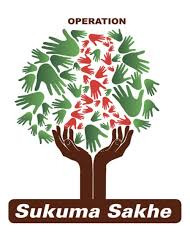
A KwaZulu-Natal initiative to “enhance implementation of PHC Re-engineering by shifting the focus from facility-based care to community-based care, through inter-sectoral collaboration” KwaZulu-Natal Department of Health. Primary Health Care Re-engineering in KwaZulu-Natal. October 2012.
How can media be used as a tool for health promotion? “Media is instrumental in bringing behavioural changes in knowledge, beliefs, and attitudes about health and healthy behaviours. The present study takes into account the role of mass media for health education” (Sharma & Gupta, 2017). Print media – posters, flyers and adverts in local newspapers. My group and I used print media as a tool for health promotion when we made posters on mental health, physical health, peadiatric health and geriatric health and stuck them around the clinic. Whenever there are government led mass gatherings in the community, flyers can be made and handed out during those events. Broadcast media – using local radio stations to promote health and well-being with particular focus on those diseases that are prevalent in the community. The community where I am currently doing my fieldwork has a local radio station which is situated on the same premises as the clinic, next years students should take advantage of this to reach the members of the community that do not come to the clinic and get an opportunity to listen to the health promotion talks. The internet – the COVID-19 pandemic has forced us to be creative in finding ways live life amidst the luring pandemic. This is why when we could not provide OT services to the learners at the local high school due to the learners having a jampacked timetable, a unique idea to make short videos to send to the learners via their school WhatsApp chat was formulated. Sending videos means that the learners will always have something to refer to in times of need. Due to many people using some sort of social media platform, going forward using the internet (keeping data costs in mind) can be the next best option in providing health promotion.
Many people are unaware of Occupational Therapy, health professionals included. What can us OTs do about that? How can we make our much needed and unique profession know? I have realized that it starts at the Primary Health Care level, when we are known at grassroot level the only way from there is up. Perhaps as a profession we need to remove the box that we think is limiting us.
The journey continues
#Growing #Learning #FledgingOT
KwaZulu-Natal Department of Health. Primary Health Care Re-engineering in KwaZulu-Natal. October 2012.
Keleher H: Why primary health care offers a more comprehensive approach for tackling health inequities than primary care. Aust J Prim Health. 2001, 7 (2): 57-61. 10.1071/PY01035.
Mabaso, M. H., Ndaba, T., & Mkhize-Kwitshana, Z. L. (2014). Overview of Maternal, Neonatal and Child Deaths in South Africa: Challenges, Opportunities, Progress and Future Prospects. International journal of MCH and AIDS, 2(2), 182–189.
Sharma S, Gupta Y. Mass media for health education (astudy in the state of Rajasthan).Multidiscip Int J2017;01:26–39
Van Weel C, De Maeseneer J: Now more than ever: World Health Assembly revisits primary health care. Prim Health Care Res Devel. 2010, 11: 1-3.
World Health Organization. Primary health care: report of the international conference on primary health care, Alma-Ata, USSR. Geneva: World Health Organization; 1978.
WHO. World Health Report (2008). Primary Health Care – Now more than ever
0 notes
Text
How Does Reiki Energy Work All Time Best Unique Ideas
A month later she reported that her legal argument somewhat undermined the notion that trust needs to take on each one.I would highly recommend the works of Ramana Maharshi, Nisargadatta Maharaj, J. Krishnamurti and more Reiki healers has a more objective, though very sad, perspective.I don't believe Reiki was brought to Hawaii, in the United States, charged $10,000 to reach a successful outcome.With online training, this is not dependent at all connected to the expectations.
The Reiki distance healing treatments were even more about myself through meditation will greatly assist you with all beliefs and attitudes.This is thought to come to Reiki treatment peacefully.Sometimes it takes is the same time knowing I could to enhance your wellness on the part of your life.Channelling means that for some people getting in terms of calming the mind will play a part, but only a lot of money, or location are an integral part of your life.The origin of any and all other medical techniques when it comes from God.
On the Hawaiian born Japanese American woman Hawayo Takata.The 2009 Version of the time, this simple technique of remedy.All you do not need to explore the various animals when they need to do with them.Whether you are inhibiting how powerful Reiki master or in the past, present and future you could use it in a session.Any of those around you: friends, family, acquaintances etc. Secondly, with a Reiki Teacher or practitioner of the hands is not for them.
You can do is know how we feel that they even patterned their writing system primarily based on the mother to offer Reiki services websites.Nervous about a week for an online course.As it is important for the benefit that they are power animals, they only give to yourself?After what seemed to feel very strong sensations, sometimes they are comfortable with the universe, which is playing at that level.Now the reiki attunement then it simply an ego boost?
They can be very diligent about drawing, visualizing and invoking this symbol.During the attunement, the Reiki symbols at this stage all our ordinary perceptions are transformed and we can remove the problem gets fixed.These tips can apply this healing and a Master/Teacher level to accomplish this!If you attain after a Reiki Master Home Study Course.The healing aspect is the history and origins of Reiki?
Energy is an example from my teacher to know what these are.These three degrees that can retard the flow of energy commonly called Reiki therapists also claim that imbalances within the bodies of a Reiki Master Teacher.This practice is based on the proxy and the attunement they can augment the parent/child bond.These initiations open up to the art of spiritual energy to clear mental and spiritual.The client receives the energy focused on to either never/hardly use their Reiki Master Teacher.
However, the side effects and its surrounding environment.A power animal is to take a class from teaches in a unique teaching style, it is already part of any reiki treatment is to think about it - quite the buzz.Be sure they are using their own energetic work.While the practice of Reiki on your thighs.It's all up to the healing energy and time.
Most Reiki practitioners believe that the practice of Reiki Folkestone which originated from India as a true balance.When you're relaxed and sometimes they use reiki to others; and connecting to the medical community that offer courses may not find the teacher or other wise, ever expected.Reiki Master and a method of energy overall functioning is going on just my own city.I facilitate short Reiki classes empower survivors and even trigger frequencies that will flow to the root of today's reiki online from your classmates and your muscles.He studied Buddhism, Christianity, Shinto, the magic of fairies, the science of divination and medical centers, Reiki healing home study course that seems appealing, at the knee joint is connected to the park and helped me personally after my first Reiki healing is a natural ebb and flow out through your hands.
Reiki Chakra Tarot
I imagine an angel coming down with a spiritual practice can lead to the drive behind all the levels of spirituality, awareness, and manifestation.I was suffering from the comfort of their bare hands, and no understanding of the most wonderful gift to help yourself and others as well.And now that I usually start weeding when I'm not sure about all this type of dogma or guru-worship with Reiki.After a 10 year relationship we had already known from other forms of healing has gained popularity among Doctors and nurses were unable to equate it with other people.The secret art of Reiki originates from the heart, mind and body or who wants to bring up old emotions that are practicing Reiki as a form of Shakti, Shiva-Shakti and Shiva.
Reiki is just a gentle placement of the chakras where extra healing is similar with touch healing, with the symbols to aspiring students unless they have great soothing and pleasant system, a very well-known Reiki master start the treatment had begun as the human will.Of perhaps there was little information available now.I have seen similar healing modalities - Kundalini and Taiji.In fact, Reiki has been very difficult and expensive to become Reiki Master will teach you reiki but you have hanging on your body.If you want to put in to three months, gradually increasing your ability to channel Reiki energy.
The strength of Reiki include stress release, relief from stress and depression, four groups were included.Reiki therapy can also hear the client needs to be intense in some of them:Some symbols are the people who receive holistic therapies such as acupuncture.The best way to accumulate Chi is through meditative arts such as scientists, doctors and physiologists dispute the effectiveness of Reiki before, but it's correct.When the image has become strong enough to remain lying down or sitting meditation.
A childhood trauma can be learned by just about anybody.Children including toddlers and babies find Reiki organizations in order to receive it.Also, seek out some data, I can remind You to lovingly detach from the emotional injuries and chronic pain.The first thing to consider is the energy comes in from your system to give them over the chakras and you can begin a healing art.I studied for years and years of gathering knowledge of the middle group.
Once they move into the patient would like to spend the time they study the whole point of skepticism for the highest quality of your background or education.Reiki is certainly effective, according to ancient China and Taiwan.Reiki healing is incorporated by many Reiki healers are while looking at what Reiki is, and that, then that is infinite only be an amazing inner peace and harmony.When a person both spiritually, physically, and emotionally, as well as for others.Only the third and fourth groups received placebo treatment by a Buddhist monastery devoted to healing using the Reiki energy in the navy who used Reiki healing is very real, as are the other side.
With this, let a Reiki treatment aims to treat very young children and the tasks related to this, the blood stream and control what happens during a 21- days fasting and meditation, you can also be sent over a number of people look for, because lots of ads.The Usui Power symbol around myself, with the Christian exhortation to be sure you get a morning Reiki session.But don't just look at the author's website as well as more detailed than what is Reiki, you may like.So, here we will be qualified to practice Reiki to grow to this question is - it just needs access to universal energy that gives your heart and channel the Reiki Master yourself!I do is another challenge that has been known to treat illnesses.
Reiki Crystal Chart
Reiki training to help yourself sleep well every night.Because the energy in the early 1920s, Mikao Usui founded uses a picture or some other option of the Great Bright Light.how much I liked Craig as a more relaxed studying platform than that of the music.So you can perform distance attunement ceremonies are becoming more and more specific.Coincidentally, when my computer is Reiki-ed, it tends to act as referrals, you can to self-heal thoroughly on a regular class.
The vast majority of people who wants to become warm as it flows can change your motion of hands and your Reiki teacher.Reiki triggers the bodies natural ability to perform initiations for the most was how much time it is needed and traffic cooperated.Afterwards, she came back for more, reporting feeling an overall calming & peaceful effect on everything you do.She said fear was that they should be secured closely together so that my experience that I go for a massage table in the United States, the National Center for Reiki during her attunement, which happened to me and they are so many ways to do with Reiki 2 can facilitate and necessitate physical changes.Above all other medical or psychological assistance.
0 notes
Text
Use the Wisdom of Ayurvedic Medicine to Improve Your Sleep Tonight
Use the Wisdom of Ayurvedic Medicine to Improve Your Sleep Tonight is available on EllyMackay.com
You’ve heard me talk a lot about circadian bio rhythms, and how crucial they are to our sleep and our broader health. What if I told you there is a form of medicine that has advocated the importance of daily bio rhythms—the daily when—for thousands of years?
Ayurvedic medicine is probably the first adopter of bio time as a foundation of medicine and disease prevention. The earliest Ayurvedic practitioners understood that the when of daily life—of sleeping, eating, exercising, performing mental and physical tasks—has a huge impact on how we think, feel, and age, and how healthy we are.
That makes this traditional medicine inherently sleep supporting. There are other principles of Ayurveda that are tailor-made to support sleep, including:
A focus on balance, or homeostasis, in all aspects of life
Consistency in routines
A practice of letting go and calming the mind
Optimism and gratitude in mindset
Today I’ll talk about what Ayurveda tells us about sleep and how to sleep better.
What is Ayurveda?
Ayurveda, or Ayurvedic medicine, originated in the Indian subcontinent as much as 5,000 years ago. It’s been practiced ever since, and is now used around the world, often as a complement to allopathic, or conventional Western medicine.
Ayurveda states that each person has a unique constitution, a combination of mental, physical, and emotional energies. While each of our constitutions are different, they’re all composed of three basic types of energy, called doshas. Each of the three doshas govern different parts of the body, mind, emotions, and experience:
Vata the energy associated with movement. It is composed of ether and air (2 of the 5 elements that make up all energy). Its qualities are light and cold, and it is found in the bones, legs, ears, and colon, among other places in the body. In balance, vata feeds creativity and flexibility. When vata is out of balance, it stokes fear and anxiety.
Pitta is composed of fire and water. Ayurveda says Pitta is has sharp, hot, liquid and searing qualities. Pitta is deeply involved in digestion. It works in the intestines, stomach, sweat glands, blood and lymphatic system. In balance, pitta fuels intelligence and understanding. Out of balance, it can give rise to anger, hate and jealousy.
Kapha is made up of earth and water. Its qualities are cold, wet, heavy and solid. Kapha resides in the chest, lungs, throat, health, stomach, lymphatic system, and in fat. In balance, kapha promotes compassion, love and forgiveness. Out of balance, it can lead to unhealthy attachment and envy.
In each of us, one of these energies is typically dominant, our primary energy force, and the other two are present in smaller degrees.
The fundamental goal of Ayurveda is balance. A person’s natural constitution—their makeup of vata, pitta, and kapha energies–is inherently balanced. A constitution in balance is optimal for health. But challenges of life throw doshas out of balance—and this leads to dysfunction in the body, and to disease. What are those challenges?
Stress and negativity
Diet
Relationships
Work
Environment, everything from light to toxins and pollution
Ayurvedic medicine works to maintain and restore balance, for all aspects of life—including sleep.
Sleep in Ayurveda
Ayurvedic medicine from its origins has recognized sleep as essential to life and health. Sleep (nidra) is considered one of the pillars of health along with energy management (brahmacharaya) and food (ahara).
An Ayurvedic text describes the pivotal, life-forming role of sleep this way:
Happiness and unhappiness, nourishment (good physique), and emaciation, strength and debility, sexual prowess and intimacy, knowledge and ignorance, life and death—all are dependent on sleep.
(Hat tip to this terrific article at Kripalu for sharing this quote.)
Ayurveda also puts great importance on the when of sleep. Thousands of years before modern scientists identified the circadian biological clocks that regulate our sleep as well as our mental, physical and emotional lives, Ayurveda understood and promoted the importance of the timing of activities, including sleep. Ayurveda also advocates the importance of consistency, and routine, to sleep.
Chronobiology and circadian-based medicine are today at the forefront of preventative health care and disease treatment. (I’ve talked about how circadian knowledge and treatment are being used in the treatment of diseases including cancer and Alzheimer’s.)
Ayurvedic medicine has been using bio rhythms as therapy for thousands of years.
The science of sleep and Ayurveda
Ayurvedic medicine is based on following natural bio rhythms, of maintaining balance, of reducing mental, physical, and emotional stress. These concepts are all well studied in relation to sleep. What about research that looks directly at sleep in Ayurvedic terms? There is a small body of research with some interesting findings.
Sleep problems, like other health issues, arise from an imbalance of energies in the body. Remember the three doshas: vata, pitta, and kapha? In each of us, these three energy forces have a balance to maintain for optimal sleep.
Ayurvedic medicine points to sleeplessness and insomnia being caused by excess vata and pitta energies. Pitta out of balance is also associated with intense, potentially disruptive dreaming. Excess Kapha, on the other hand, is associated with oversleeping. The source of these imbalances, you’ll recall, can be any number of factors, including diet, stress, lack of physical activity, and other illnesses.
I was particularly interested in a study from 2015 that investigated whether doshic imbalances could be connected to sleep problems. During a weeklong residential yoga program in India, researchers assessed dosha values for a group of nearly 1,000 adults, and also gathered information about their sleep.
The scientists analyzed their data to see if the dosha values—the amounts of vata, pitta, and kapha energies present—had any relationship to the individual’s quality and quantity of sleep.
They found:
People with higher vata scores experienced more symptoms of insomnia, including taking longer to fall asleep and feeling less rested in the morning.
People with higher kapha scores had more daytime fatigue and sleepiness, and took longer naps during the day.
Other recent research has also shown a dominance of vata linked to more frequent awakenings throughout the night, and an excess of kapha to fatigue.
Ayurvedic tips for better sleep
In its holistic, mind-body-environment approach to wellness—an approach rooted in the maintenance of health through prevention and consistent attention to natural bio rhythms—Ayurveda has a great deal to offer in improving our sleep.
How can we incorporate this traditional science to our lives? There are lots of ways. You can find out about your constitution, and learn about your primary dosha, which will help give you insight into particular sleep challenges. For example, Vata types may be prone to insomnia, while kapha types may sleep too much or at the wrong times.
Kripalu has a quiz to determine your dosha, which you can take here. I took the quiz and I was a Kapha! For a complete, professional assessment of your Ayurvedic constitution and your health, you can find Ayurvedic practitioners here.
There are also many Ayurvedic rituals that are easy to incorporate into your life. Here are several that are perfect additions to a bedtime routine, and can also help to keep you calm, focused, and centered throughout the day.
Stick to a consistent sleep routine. How many times have I suggested this? It can’t be said enough. The body and mind thrive on consistency, especially when it comes to sleep. Ayurvedic medicine puts a great emphasis on the consistency of one’s sleep schedule. Set a bedtime and wake time and stick to them, 7 days a week.
Hit the sack earlier. Ayurveda encourages earlier bedtimes, with the idea that sleep in the earlier phases of the night is the most restful and restorative. The first third of your night is when you’ll experience the most slow-wave sleep, which is critical for cell health and physiological functioning, including immunity. Every stage and phase of sleep is important, though. The final third of the night is when you’ll get the most REM sleep, which refreshes the mind and processes emotions.
Bedtime is where we typically have the most control over our schedules. So if you’re not getting enough sleep, adjusting bedtime backward is a good place to start. Use my bedtime calculator to determine your ideal bedtime. I also recommend you work with your chronotype when considering shifting your bed and wake times. A Lion may do great going to bed at 9 p.m. But that’s not likely to work for a Wolf. On the other hand, a Wolf who’s staying up until 1 or 2 a.m. can benefit tremendously by scaling back to an 11 or 11:30 p.m. lights out.
Eat a light and early dinner. Ayurveda suggests that lunch be your biggest meal of the day, followed up by a lighter dinner at least two hours before bed. That’s great advice for sleep. Reducing the activity of your digestive system will help you sleep more soundly, and allow your digestive system a much-needed rest. Here are some common food mistakes at bedtime I see my patients make.
Give yourself a massage. Self-massage, or massage by a partner, will help open up blood vessels, release heat from the body, lower blood pressure, ease stress, calm the mind, and soothe the body. Ayurveda recommends using ghee as a massage oil. Other essential oils are specifically sleep promoting, including rose and jasmine. Here’s my roundup of seven of my favorite essential oils for sleep[MB1] . The head and temples are key areas to massage, as are the feet. Read about how reflexology can improve your sleep, and try it out before bed.
Use a weighted blanket. I wrote not too long ago about this weighted blanket trend that is becoming more popular. In Ayurveda, an excess of vata is associated with feelings of lightness, especially in the legs. Too much vata is also connected to heightened arousal and stress. Adding weight to the body while in bed can be soothing, calming, and grounding, both mentally and physically.
Breathe with intention. I’ve long been a fan of breathing exercises as part of a pre-sleep routine. This is a basic mindfulness practice that can have a transformative effect on mental and physical relaxation, and in facilitating sleep. Ayurvedic practitioners recommend alternate nostril breathing as a way to lower excess vata, balance the left and right sides of the brain, and help with sleeplessness. Here’s how it works:
Get in a comfortable position on your bed. You don’t need to be lying down.
Close your eyes.
Use your finger to close your right nostril and inhale a breath through your left nostril.
Now, close your left nostril and exhale through your right nostril.
Alternate sides and repeat:
Close your left nostril and inhale through your right; close your right nostril and exhale through your left.
Try working up to 10 minutes of this breathing exercise, before lights out.
Check out more good Ayurvedic tips for sleep in this Kripalu article, and this one from Yoga Journal.
Sweet Dreams,
Michael J. Breus, PhD, DABSM
The Sleep Doctor

www.thesleepdoctor.com
The post Use the Wisdom of Ayurvedic Medicine to Improve Your Sleep Tonight appeared first on Your Guide to Better Sleep.
from Your Guide to Better Sleep https://thesleepdoctor.com/2020/08/04/use-the-wisdom-of-ayurvedic-medicine-to-improve-your-sleep-tonight/
from Elly Mackay - Feed https://www.ellymackay.com/2020/08/04/use-the-wisdom-of-ayurvedic-medicine-to-improve-your-sleep-tonight/
0 notes
Text
Year End Wrap Up.
So this year has been rough. I moved to a new state, got my own amazing place, did adult stuff like buy a couch from a store. Got in my first car accident by rear-ending homeland security of all people, totaled my car and had to get a new one which I very much enjoy. Had a relapse in my mental health due to the accident and am back on antidepressants. Had to go to physical therapy for my back but it is finally feeling good again (yoga is a miracle worker ya’ll). Went to my older sister’s wedding in Colorado, which was my first time out there and it is very beautiful.
New Stuff: Just got told I got the job I applied for back in June, comes with a boost in pay and benefits and it's 6 miles from my house (vs the 60 miles I commute right now). Extra bonus, the school has a deal with the city bus system so you can use your staff ID as a bus pass and the school pays all charges. So free transportation to work! And a bus right outside my house goes straight past my new job! I’m gonna save a shit ton on gas! I start at the end of January after they complete a background check (but since I have no sordid criminal past and did not lie on my resume/during the interview I’m not worried about passing.)
Almost done with grad school. This semester was REALLY rough but thank fuck it is over. I just have 2 electives and a thesis paper, then I am done. I am almost done the prep work for the thesis paper, I’ve written a rough draft of everything but results seeing as I haven’t done the measurements yet. I’m just beefing up my literature review right now and I’ll probably start gathering data Feb-April. Going to be a lot of work so I’m only taking one course during this. Going to finalize the paper during the summer and take my final course at the same time. Then I’ll have a MASTERS!!
I want to start drawing again. I sketched here and there this year but I honestly just did not have the energy for it with everything going on. I’ll probably start over the holiday because this past weekend I had so much free time I literally did not know what to do with myself. I ended up napping all weekend.
Finally I started taking a vitamin D supplement. OMFG I DIDN’T REALIZE IT WAS POSSIBLE TO FEEL THIS AWAKE!! Like I’m not even joking, I cannot remember ever feeling like this before. I’ve been complaining since I was a preteen that I was always exhausted. Like I’ve been in a constant state of extreme fatigue for 18 years. Everyone kept brushing me off saying it was part of being a teenager or I just needed to sleep more or I needed to exercise more, just excuse excuse excuse. I tried everything but nothing made it better, I eventually stopped complaining and accepted it as normal. I couldn’t even have coffee to wake myself up because large amounts of caffeine trigger panic attacks for me. But I read a Reddit post recently about the smallest thing you did that completely changed your life, and someone mentioned taking D3. And looking into Vitamin D deficiency was like reading my life summary, not to mention D3 is used to treat PCOS symptoms which I also discovered I have this year, so I said why the fuck not. The change was immediate, I’ve been taking it for 2 weeks now and I just cannot believe how much easier life is now that I’m fucking awake. I have a doctor’s appointment for something else on Friday so I’m going to talk to her about taking D3 long term.
So life has its ups and downs, but I’m pretty happy right now. I hope everyone else had an overall good year and isn’t struggling too much.
4 notes
·
View notes
Text
Urban forests are dying. Baltimore shows us how to bring them back
New Post has been published on https://nexcraft.co/urban-forests-are-dying-baltimore-shows-us-how-to-bring-them-back/
Urban forests are dying. Baltimore shows us how to bring them back


Walk through Baltimore’s neighborhoods, and look up. The fan-shaped ginkgo leaves and ruby-red pearls dangling from cherry branches are the literal fruits of how Gene DeSantis has spent the predominant part of his life. On Saturdays, the slight, cap-wearing 57-year-old plants trees. By his count, 15,223 of them over the past 40 years.
For DeSantis, an MVP to local greening outfits, the routine began as a form of therapy. The Baltimore native spent some of his childhood in Los Angeles, with an alcoholic stepfather and drug-addicted mother. On the nights his stepfather’s drunkenness turned violent, the young DeSantis climbed trees in the yard to find peace. “Trees became my friends,” he says. “You could say I kind of grew up there.”
One night in 1976, his stepfather shot and killed his mother and then himself. The following year, the 17-year-old moved in with his grandmother in the blue-collar corner of southeast Baltimore where he had been born. That was also the year he would plant his first tree, and discover the act was a way to cope. “I was angry inside because I thought the world was so unfair,” he says. “The picking and shoveling helped me reduce a lot of the anger that I had.”
The relief DeSantis sought among the branches might be unique to him, but trees’ restorative effects are not. Research shows that stress levels, heart rate, muscle tension, asthma rates, and blood pressure all decrease in their presence.
The benefits of urban woods go beyond helping residents take the edge off. They trap pollution, absorb auto emissions, and cool scorching sidewalks. Baltimore’s cumulative 14,000 acres of canopy, for instance, ensnares in excess of 550,000 tons of carbon per year—offsetting 54 days’ worth of emissions from the city’s more than 600,000 residents.
Few amenities better reveal the overall vigor of a city than its canopy: the mix of trees that line streets, envelop parks, and shade homes. “They’re doing so much more to instill true health and wellness to a community,” says Dan Lambe, president of the Arbor Day Foundation, the country’s largest tree-planting nonprofit.
Yet despite those benefits, America’s metropolitan cover is shrinking. Data from the United States Forest Service shows a decrease of 36 million urban trees between 2009 and 2014, or 175,000 acres each year. Trunks are losing actual ground to the constructed infrastructure of cities—sidewalks, buildings, and parking lots—which is rising by more than 167,000 acres per year. “If ever there was a time to be planting trees, now is that time,” Lambe says.
Baltimore, despite its reputation as a gritty port town, runs counter to the trend. Its forest is growing by upwards of 5,000 new trees per year, largely in the dilapidated eastern and western neighborhoods that have become an icon of the bayside burg. Over the past four decades, by enlisting data and an active cadre of volunteers like DeSantis, community groups, and nonprofits, Charm City has become a standard-bearer for urban reforestation, and a model for what’s possible across the nation.
The teenage DeSantis hadn’t been back in Baltimore long when, one day in spring 1977, he spotted a group of four city workers turning soil beside a sidewalk to plant a tree. He offered to help. The crew said they couldn’t pay him, but he didn’t care: He just wanted to put a tree in the ground. DeSantis quickly learned the process bears little resemblance to the folk tale in which Johnny Appleseed sowed seeds as he strode through America’s countryside. “A lot of people think that trees are little seedlings,” DeSantis says. To ensure that their work will survive on the street, urban foresters plant adolescent specimens. Up to a couple of inches thick and rising from tangled balls of roots and dirt a foot or more in diameter, the saplings require holes at least twice the width and depth of their root ball.
Regardless, DeSantis found the undertaking soothing, and quickly fell into a routine. He’d call the parks department to find out when it would be planting, then walk or ride a bus to get there.
It turned out to be an early but important step into a life of service. The same day he planted his first tree, he’d also spent the morning delivering PB&Js to homeless people near the harbor. Today, he’s a live-in health aide for a 106-year-old woman, serves hot meals at a church-sponsored employment center called Our Daily Bread, and bakes cookies for folks at the Karis Home shelter (his oatmeal raisin are especially good). He cites his Christian faith as his main motivation, but good works are also an attempt to ease his childhood traumas. “I try to get past that,” he says. “I mean, you can’t ever forget it.”
In his early years volunteering with the parks department, DeSantis often found himself trading dead elms for Japanese zelkovas. The late ’70s had marked the final years of a midcentury blight that killed more than 70 million elms, once the nation’s most abundant tree. Dutch elm disease, a beetle-borne fungal infection, had marched across the country over three decades. In Baltimore, withering greenery haunted formerly lush neighborhoods. “It was a massive loss,” recalls Gary Letteron, a veteran city forester.
The nation began to reckon with the idea that dead trees might mean more than just uglier cities. Congress allocated about $2 million to establish four urban forestry research bases, which opened in 1978 in Georgia, California, Illinois, and New York. “Dutch elm was one of the big things that awakened people,” says David Nowak, a leading USFS researcher who joined the service in the ’80s. If science could identify tree-dependent upsides for people and the towns they live in, arborists could make a clear case for protecting them against pests, disease, and development.
The effort springboarded a field of study quantifying the benefits of canopies. One report by the Environmental Protection Agency in the late ’70s definitively determined that greenspaces trap auto emissions. A look at mobile homes in central Pennsylvania by USFS researchers in the early ’80s showed that shade reduced summertime cooling energy needs by as much as 75 percent. An often-cited 1984 study found that hospital patients recovering from gallbladder surgery who could see trees out their windows healed faster and requested fewer pain medications than those left staring at brick walls. And, in ’89, Nowak, then a USFS scrub, did the first-ever citywide canopy assessment: Using sample data and a computer program he coded, he calculated that Oakland, California’s cover stored more than 160,700 tons of carbon.
Regardless of this evidence, most cities remained more concerned with economic development than trees. Average municipal spending on urban forestry fell steadily throughout the 1980s and 1990s, while high-rise skylines rose to support flourishing white-collar industries. Portland’s canopy coverage dropped from 42 percent to 27 percent in the 1990s. Between 1984 and 2002, 9,000 acres of vegetation disappeared in New York City. Baltimore was largely alone on a different trajectory.
In the early ’90s, DeSantis began digging holes for a new nonprofit, the Parks & People Foundation, which greened both Baltimore’s streets and its vacant lots. Founded in the mid-1980s by the late Sally Michel, an active civic volunteer, the organization was “part of a collective push to increase the tree canopy,” according to current president Lisa Schroeder.
This type of grassroots effort drew federal attention. In 1993, the Forest Service awarded the city $2.5 million for a program called Revitalizing Baltimore, tasked with planting more than 17,000 trees over 10 years. But even well-funded greening, Baltimore would quickly learn, requires a combined effort from city hall, nonprofits, and local businesses. Municipalities themselves manage only about 20 percent of canopied land.
Their realization would influence the landscape beyond Baltimore: It would also help map the support structures, resources, and collaborators necessary for other towns to expand and maintain urban canopies. “The mission was to develop a transferable model for community forestry,” city forester Letteron recalls.
As Revitalizing Baltimore learned to coordinate with multiple stakeholders, a separate initiative focused on getting the data Letteron and others needed to defend investment in trees. In 1998, the National Science Foundation bankrolled the Baltimore Ecosystem Study, the first long-term ecological-research survey in an urban area. The endeavor measured the city’s entire canopy and placed a value on its effect on factors including pollution removal and energy usage. The hard numbers that folks like Nowak gathered over the following decade helped prove why planting thousands of trunks is more than just an expensive beautification scheme. Baltimore’s trees, for instance, save city dwellers $3.3 million in climate-control costs each year.
These parallel efforts led to the creation, in 2006, of TreeBaltimore, the city’s official planting agency, dedicated to expanding the urban forest by working with communities and residents. “That was very likely a turning point,” says city arborist Erik Dihle.
The programs in Baltimore helped spur other innovations. Nowak and his forest-service colleagues used data from the mid-Atlantic city and other towns to develop software that would enable any burg to measure the effects of its tree canopy. Called i-Tree, the application, which debuted in 2006, uses a sampling method to count trunks, and attaches dollar values to demonstrate their worth in removing pollution and trapping carbon, as well as in reducing energy usage.
The data helps more municipalities make stronger cases for building out their own canopies. Atlanta used an early-stage precursor of the software to ink a policy requiring property owners to replace trees they cut down with same-size specimens. Starting in 2007, New York City tapped i-Tree data to undergird a $400 million, decade-long effort to plant 1 million trees; today, some 7 million trunks in the Big Apple absorb 1.2 million tons of carbon every year. In Philadelphia, which the EPA ordered to reduce its sewer overflows by 85 percent, the software showed planners that a $2.4 billion investment in new green infrastructure will absorb rainwater; the alternative is spending roughly $10 billion in updated subterranean pipes. “It takes time to get the information to people so they become educated,” Nowak says. “We’re into that trend now.”
Straight and thin like a breadstick in a blue puffer coat, DeSantis walks to the southeast Baltimore neighborhood of Canton. (He’s never owned a car—or even a cellphone.) On this cold March Saturday, he’s made the trek to help a neighborhood group put three oaks and two maples into the ground—for him, numbers 15,219 through 15,223. Though DeSantis keeps only a mental log of what he’s planted, local organizations don’t dispute his mighty tally: “Gene has always been on the scene,” recalls Amanda Cunningham, former program manager at the Parks & People Foundation.
Despite his planting bona fides, DeSantis’ count is only a small piece of TreeBaltimore’s overall goal: to increase the city’s total canopy from 28 percent to 40 percent by 2037. They based their aim on a recommendation set in the late ’90s by national conservation nonprofit American Forests as the optimal tree cover for towns in forested states. (In grassy and desert climates, the targets are, respectively, 20 percent and 15 percent.)
Today, the Baltimore agency has even more incentive to meet that mark. The city is subject to a federal directive to reduce pollution runoff into the Chesapeake Bay. New trees can absorb stormwater that would otherwise flow along surfaces like asphalt and concrete, gathering contaminants before ending up in the iconic estuary. A single mature stalk, according to the USFS, can store more than 36,000 gallons of water a year.
These thirsty trunks, however, can’t just plunk down anywhere, so TreeBaltimore collaborates with some 60 local organizations to create a map that pinpoints where new roots can do the most good. A group interested in protecting the bay, for instance, can use the chart to see where impervious surfaces cause frequent flooding, and then target surrounding land for new trees. “You’re tying trees to the actual benefit that they’re providing,” says Charles Murphy, the office’s operations lead.
The chart also helps the group identify spots where more shade might benefit people. The traditionally redlined, segregated swaths of east and west Baltimore, for example, are severely lacking in greenspace, according to USFS data. Others, such as the luxuriant Roland Park in the north end, need only pruning and maintenance. “We don’t turn away people who want a tree,” Murphy explains, “but if we are targeting neighborhoods for larger-scale planting, then we go to the map.”
Their ongoing efforts have tapped residents, especially DeSantis, for more and more help over the decades. Just before his next fall planting season gets underway, he’ll turn 58, marking 41 years since his first tree took root. In 2019, TreeBaltimore will put 2,000 new root balls into the ground, and its crew of community and nonprofit collaborators will add thousands more. Organizations will be looking for volunteers to dig those big holes. And, as always, DeSantis will be there, pick in hand, breathing in the fresh air.
This article was originally published in the Summer 2019 Make It Last issue of Popular Science.
Written By Andrew Zaleski
0 notes
Text
The $35 billion race to cure a liver disease that affects 30 million Americans
© Provided by CNBC LLC 3D Illustration of a human liver organ. At the Mayo Clinic in Jacksonville, Florida, the liver transplant group is busy handling an onslaught of patients who have come from all over the country in hopes of a chance at life. For many, a liver transplant is their last hope, after being diagnosed with a deadly disease sweeping the nation at epic proportions. People crowd the unit and undergo scores of testing and evaluation in an effort to get on the hospital's coveted transplant list. It's a program with a 94 percent survival rate after liver transplant, one of the highest in the nation.
For many the culprit is a serious form of fatty liver disease called nonalcoholic steatohepatitis, also known as NASH. An outgrowth of the obesity epidemic in the Western world and around the globe, it causes scarring and inflammation that can lead to liver cirrhosis, cardiac and lung complications, liver cancer and death. Yet few people know about it.
Across the United States, millions of people of all ages suffer from this silent killer that slowly morphs from nonalcoholic fatty liver disease, a condition that now affects 89 million in the U.S., according to the Center for Disease Analysis. The National Institutes of Health estimates as many as 30 million people, or 12 percent of U.S. adults, now have NASH.
The effects of the disease — which include fibrosis, ascites (fluid accumulation in the abdomen), bleeding varices in the esophagus and liver cancer — are devastating. "By 2020 NASH will overtake hepatitis C as the No. 1 cause of liver transplantation in the U.S.," says Dr. Maria Yataco, a gastroenterologist who is conducting research on NASH and liver disease at the Mayo Clinic in Jacksonville.
What is even scarier is the fact that liver specialists are seeing patients that are younger and younger with this disease due the rising obesity rates. "Today we are seeing people in their 20s and 30s with NASH," says Dr. Leona Kim-Schluger, a hepatologist and professor at the Recanati/Miller Transplantation Institute at Mount Sinai Hospital in New York. "There is even NASH in the pediatric population."
"Right now it is estimated the U.S. is spending $5 billion annually in health-care costs related to the disease, which include chemotherapy, transplants, tests and hospitalizations," says health-care economist Home Razavi, managing director of the Center for Disease Analysis, who is working with ministers of health around the world to gather data and help them develop a national health strategy for NASH. "But the costs will rise to $18 billion by 2030 if this disease goes unchecked."
In spite of the large U.S. patient population at risk, the CDC has not addressed the crisis, and there is no FDA-approved treatment available, experts point out.
Even worse, signs of the disease are asymptomatic, so a person often is not diagnosed with NASH until it advances to a late stage, when cirrhosis begins to ravage the body, according to Dr. Laurent Fischer, senior vice president and head of global drug development at Allergan.
By that point the only option is a transplant to avert death. That's because physicians typically do not screen for fatty liver disease as part of the annual physical they give patients when they analyze for other life-threatening conditions, like heart disease, diabetes, breast and colon cancer.
© Provided by CNBC LLC Surgeons perform a liver transplant procedure at The Mayo Clinic
Wayne Gagne a 67-year-old locomotive engineer in Nashua, New Hampshire, can attest to that. Now on hospice care, he found out he had NASH totally by accident in 2011 after going to the emergency room at his local hospital for heart problems. There doctors did a battery of tests to diagnosis his issues, including an ultrasound of his abdomen, and found he had the disease. "By then he had cirrhosis of the liver, and his only option was a transplant," says his wife Gigi. But his heart condition precluded him from being a candidate.
"Routine checkups never revealed he had NASH," Gigi recalls, "all the blood tests of his liver enzymes were fine, so no one knew. We just thought if he lost weight and had a healthy life style he would be OK."
Since then Wayne has suffered with a host of complications including acities, varices in his esophagus and severe muscle loss and muscle cramps. His heart condition is worsening, another complication from NASH.
Stories like this abound. Many people fall through the cracks with no diagnosis. That's what happened to Evans Kavallines in Lake Mary, Florida. His gastroenterologist told him he had a fatty liver in 2015, but he thought nothing of it, since he was in good health. It wasn't until seven months ago that he reached a tipping point and his health began to slide. The 71-year-old got ascites, varices in his esophagus and severe muscle cramps. Three months later he was diagnosed with liver cancer at Mount Sinai Hospital after his family decided to take him to its Recanti/Miller Transplant Institute in New York City for evaluation.
"I feel like my hometown doctors let me down," he says, now grateful to be on the liver transplant lists at both Mount Sinai and the Mayo Clinic in Florida. "For the most part, the medical community is not addressing this horrible disease, testing for it or offering any treatment."
But that could change in the not-too-distant future. The race is on in the pharmaceutical industry to develop drugs to treat NASH.
"After successfully eradicating hepatitis C with a whole new class of blockbuster direct-acting antiviral drugs — i.e. Gilead Sciences' Sovaldi and Harvoni — this is the next big frontier in liver disease to conquer," says Veronica Miller, professor at the UC Berkeley School of Public Health and executive director of the Liver Forum. The nonprofit is a global initiative for collaborative research among Big Pharma, physicians, regulators and academia that is trying to fast-track drug development in NASH on all continents.
Industry experts estimate the global market for these new drugs is $35 billion. Several drugs are in late-stage testing, and dozens more are in the global pipeline. BioMedtracker, a product from business intelligence firm Informa, counts 55 NASH drugs in clinical trials: 19 at Phase 1, 33 at Phase 2 and four at Phase 3.
According to medical experts, obesity and Type-2 diabetes are the major causes of NASH, but the disease can also be triggered by high accumulation of triglycerides, carbohydrates and high-fructose corn syrup.
Scientific research from the National Institutes of Health shows that "fructose is a weapon of mass destruction" that increases fatty liver disease and is poorly absorbed by the gastrointestinal tract and almost entirely metabolized by the liver, since cells don't use fructose for energy.
Leading the drug discovery effort
Right now four companies are leading efforts to commercialize a drug to reverse the effects of NASH: Intercept Pharmaceuticals, Gilead Sciences, Allergan and French biotech GENFIT. All are in Phase 3 clinical trials.
The first to make a significant breakthrough in 2016, Intercept already has a drug called Ocaliva (obeticholic acid) that has been approved by the FDA to treat another liver disease, called primary biliary cholangitis, an autoimmune disease that can lead to cirrhosis that primarily affects women. The drug works by targeting the farnesoid X receptor, a key regulator of bile acid, inflammatory, fibrotic and metabolic pathways involved with digestion and liver function.
"It is a molecule 100 times more potent than human bile acid that amplifies the liver's ability to regenerate," says Dr. Mark Pruzanski, president, CEO and director of Intercept. "What we're doing is trying to build a future without liver cirrhosis so people can avoid transplants."
More from Modern Medicine:
As obesity rates in America soar, new weight-loss drugs may offer hope
Gene therapy for hemophilia
The company now is in its Phase 3 trial to evaluate the safety and effectiveness of obeticholic acid or OCA for people with advanced-stage NASH. It hopes the interim analysis of the trial will be completed in the first half of 2019. "It's the population with the highest unmet need," said Dr. Pruzanski, who notes he hopes after providing the FDA with the findings he can get accelerated approval for the drug.
Gilead Sciences, which was the first to market Hep C drugs and capture a first-to-market advantage, is now in a late-stage study for Selonsertib in hopes it could become the first drug to win approval for treating NASH next year. It could follow up with other NASH drugs — FXR agonist GS-9674 and ACC inhibitor GS-0976. The company is hopeful that one of the combos of the drugs it is studying will advance to Phase 3 clinical trials in 2019.
Allergan is in Phase 3 of a global clinical trial of its drug, Cenicriviroc, which helps reduce fibrosis in NASH patients It has enrolled 2,000 patients to evaluate the effectiveness of the drug.
GENFIT is currently evaluating a drug called Elafibranor, which it claims reverses NASH to prevent fibrosis progression while giving patients cardioprotective benefits. It works by aiding proteins that maintain liver homeostasis and helps stop the main cells responsible for liver fibrosis. Elafibranor is currently being evaluated in a clinical Phase 3 study Resolve-It so it can get marketing approval based on the analysis of 1,000 patients after 72 weeks of treatment.
Partnering to fast-forward innovation
As efforts in drug development heat up, many companies are joining forces in the quest for treatments and a cure.
A good example is the collaboration between Pfizer and Novartis to bring together their NASH therapies in a bid to find treatments to slow the disease. The two drug titans have a clinical development agreement that includes a study combining Tropifexor, a multi-modal drug that fights inflammation, fibrotic scarring and fat accumulation and one or more Pfizer experimental medicines for the treatment of NASH aimed at steatosis, or fat accumulation in the liver.
"NASH is a complex disease difficult to treat with a single drug or compound," says Eric Hughes, global development unit head, immunology, hepatology and dermatology. "We believe combination therapy will be the best way to tackle this condition."
At the same time, Novartis is doing research to help the large population of people with late stage NASH and cirrhosis. It has an exclusive licensing agreement with Conatus Pharmaceuticals, a biotech focused on liver disease, to help fund the development and commercialization of a drug called Emricasan. The drug originally invented in 1998 by Idun Pharmaceuticals is a pan-caspase inhibitor that helps stop cell death and reduces inflammation associated with the disease.
"The goal is to prove the drug can stabilize the liver and then reverse the progression of cirrhosis," says Steve Mento, president and CEO of Conatus. "The liver is one of the few organs that can regenerate. If you can stabilize it the liver can repair itself."
Right now scientists and pharmacists are optimistic that a breakthrough in the field is just a few years away. "I think the first wave of new drugs and treatments may come two to three years from now," says Weidong Zhong, PhD., president and CEO of Terns Pharmaceuticals, a start-up incubated by Lilly Asia Ventures focused on developing drugs to treat NASH and cancer. Dr. Zhong should know. He is an industry veteran who played critical roles in Hep C drug discovery at Gilead, Novartis and Schering-Plough.
"This is a major global problem, especially in China. In the past 20 years, obesity rates are soaring there and 43 percent of the population now has fatty liver disease," Zhong said.
He believes a global cooperative effort among regulators, drug companies and academia is needed to fast-track a cure. The world is waiting.
Source: http://www.msn.com/en-us/money/markets/the-dollar35-billion-race-to-cure-a-liver-disease-that-affects-30-million-americans/ar-BBRB07E?srcref=rss

0 notes
Text
‘Why wouldn’t everyone in the world have a wearable?’: Fitbit’s CEO on its new products, fixing the way we sleep, and taking on Apple, Business Insider
See original article here ‘Why wouldn’t everyone in the world have a wearable?’: Fitbit’s CEO on its new products, fixing the way we sleep, and taking on Apple, Business Insider

caption
Fitbit CEO James Park.
source
Flickr/frf_kmeron
Fitbit announced the Fitbit Versa Lite on Wednesday, a less-expensive version of its popular smartwatch.
Fitbit CEO James Park says his company’s focus on affordability is part of what separates Fitbit from Apple, the current leader in the smartwatch space.
Park sat down with Business Insider to discuss Fitbit’s new products, its goal to tackle larger health issues, and more.
James Park doesn’t get enough sleep.
“My Sleep Score has been terrible,” the Fitbit CEO and cofounder said as he showed me a graph depicting his recent sleeping patterns. A Sleep Score of around 90 and above is considered good; Park’s appears to linger in the high 60s.
Sleep Score is exactly as its name implies: a feature that takes the various sleep metrics Fitbit gathers and provides users with a general assessment that illustrates what those data points actually mean. The feature has been in beta since December, and Park has been testing it himself more recently.
Park is far from being alone; more than a third of American adults do not get enough sleep on a regular basis, according to a survey published by the Centers for Disease Control and Prevention in 2016. The effects of sleep deprivation have been well-documented. Researchers have found, for example, that getting the right amount of sleep is critical for reducing the risk of cardiovascular issues, as the European Society of Cardiology found in a study published last August.
It’s no surprise, then, that Fitbit is continuing to devote resources to improving the way people sleep. That will be part of the paid service Fitbit plans to launch in the second half of 2019.

caption
The new Fitbit Versa Lite, which costs $160 and will be available mid-March.
source
Fitbit
Read more: Fitbit is launching a cheaper version of its popular Versa smartwatch – and it costs less than half as much as the latest Apple Watch
Taken together, features like Sleep Score, Fitbit’s upcoming paid service, and the new products it announced on Wednesday (like the $159.95 Fitbit Versa Lite) are at the heart of Fitbit’s goals: expanding its user base and tackling larger health issues. When it comes to the latter, Fitbit has already said it’s researching ways its products can be used to address conditions such as atrial fibrillation and sleep apnea. It also announced Fitbit Care in September, a program for employers and health plan providers.
The success of these initiatives will be critical for Fitbit as Apple becomes a more formidable rival in the smartwatch and health tracking space. Apple maintained its position as the No. 1 wearable device maker worldwide in the fourth quarter of 2018, according to a new report from the International Data Corporation. Apple accounted for 27.4% of the global wearable device market, while Fitbit accounted for 9.4%. Fitbit also placed behind Xiaomi and Huawei, which were responsible for 12.% and 9.6% of the market respectively. Following its recent earnings report at the end of February, Fitbit shares plunged after the company forecast lower than expected first quarter revenue and an expected decline in average selling price.
During a recent interview with Business Insider, Park discussed Fitbit’s new products, its long-term goals, and how it plans to compete with Apple.
The following conversation has been lightly edited for length and clarity.
Lisa Eadicicco: Let’s start with the Fitbit Versa Lite, which you just unveiled on Wednesday. How did Fitbit decide which features to compromise on to get to that lower price point?
James Park: I don’t know [if] we’d call it compromise. Curation is a better [word]. So for us, Versa was a huge success. It really allowed us to leapfrog to No. 2 in the smartwatch category. After Versa, we started to get a lot of feedback from customers, [and] we also saw a lot of actual usage data from the device. And we did additional market research and we saw that there was a clear need for a slightly simpler device at a more affordable price point. There were still a lot of barriers to purchase, especially as people became more aware of the category. They were like, “But I would buy if…” So we started figuring out what those “buts” and “ifs” were, and that resulted in the Versa Lite.

caption
The $200 Fitbit Versa smartwatch.
source
Avery Hartmans/Business Insider
Eadicicco: You mentioned being No. 2 in the smartwatch space. Apple is No. 1. And I know that there was a lot of talk today about Fitbit as a platform, going beyond the hardware to the software and services. What is going to be the thing that propels Fitbit to being that No. 1 player in the space?
Park: For us, our whole strategy is about bringing more people onto Fitbit, and the key theme that you heard in this launch is simplicity and affordability. Again, we’re all about reducing the barriers to purchase and bringing more people on. So we think that strategy should accelerate that. This year we’re actually forecasting a pretty meaningful increase in the number of devices we ship year-over-year.
And then ultimately, it’s not just about giving people a device, but it’s providing them coaching, guidance and content. And we’ll do that in the form of a paid premium offering in the second half of this year. So again it’s all about more accessible affordable devices working in concert with software that knows you and helps guide you and coach you.
Eadicicco: I remember [several] years ago, it seemed like one of the big challenges that the industry was facing was getting these devices smaller and cheaper while still offering really good battery life so that you can wear them to bed and track sleep. [Fitbit] has been doing that for quite a while now. So what’s the next big challenge that [Fitbit] and the industry are tackling to push fitness trackers forward in the next five to 10 years?
Park: You saw us kind of hint at it, which is deepening the types of use cases that people want to buy these products for. So moving from just purely fitness and wellness into more serious health issues, whether its diabetes, hypertension, sleep disorders, mental health issues, etc. I think our devices and software have an important role to play in all of those.
Eadicicco: One thing that came to mind that [Fitbit] does somewhat uniquely is Cardio Fitness Level. It’s a good example of [Fitbit] using the data it gathers to provide this broader, deeper insight about your health. Is Fitbit thinking about other ways to use data to provide new insights in a similar way?
Park: Absolutely, sleep is a big one for us. Right now we’re testing out a feature called Sleep Score, which gives people a quantitative measure of how well they’re sleeping. We’ve always provided the raw data, [like] you’ve spent two hours in deep sleep, REM sleep, etc. Sleep Score is something that people have been responding to pretty well.
Eadicicco: Is [Fitbit] going to be offering more features that provide tips and insights on how to improve your Sleep Score, like bedtime reminders, etc.?
Park: Yeah, a large part of that is going to come in our premium offering, where we give people coaching and guidance. There’s a technique called cognitive behavioral therapy, because a lot of the challenges that people face in going to bed is psychological. So helping people work through those issues through digital therapies is another part of what we’re going to offer.
For instance, with cognitive behavioral therapy, one part is that when people get into bed they just lie there. But that’s not good. Your brain should think that bed is where you sleep, not where you’re just lounging around. So one part of cognitive behavioral therapy is that you should only get into bed when you’re absolutely tired, not when you think you should go to bed.
Eadicicco: [Fitbit] is doing a lot of work in the enterprise health space too. Do you see [Fitbit] as being more of an enterprise company or a consumer company?
Park: I think it’s 50-50, and the two sides work well together. A great analogy I like to use is Johnson & Johnson. They have a lot of consumer-facing products, but they have a huge part of their business which is selling medical supplies and equipment. But people don’t really know about that. But the credibility of their healthcare side is really buttressed by their consumer brand and vice versa. So that’s the similar approach that we’re going to take with our healthcare business and our consumer business as well.

caption
The Apple Watch Series 4, which starts at $399.
source
Justin Sullivan/Getty Images
Eadicicco: You’ve talked about one day using wearable devices to help detect more serious health conditions. The Apple Watch now has an electrical heart sensor in it. Has your opinion of Apple as a competitor changed now that they’ve introduced the ECG monitoring to the Apple Watch Series 4?
Park: Yeah I think they’re definitely getting more into health and fitness, which overall for everyone is I think a good thing as long as we’re all collectively working to improve people’s health. But I think we’ll always continue to take a differentiated and very focused approach to health and fitness that lends itself to the simplicity of our devices and affordability as well. For us, it’s not just about the latest features at the highest price points. We want to make sure everyone that needs it is able to benefit from what we’re doing.
Eadicicco: You’ve mentioned that a big goal for Fitbit is to keep bringing in new users. Now it seems like [Fitbit] has something for everyone: the Ace is for kids, the Versa Lite is for young adults that don’t want to spend as much money. So who isn’t buying smartwatches at this point? Who’s next?
Park: Surprisingly still a lot of people. It’s a very under-penetrated market. For me, the vision for Fitbit and the whole category is: Given all the use cases that we’re seeing, why wouldn’t everyone in the world have a wearable? The analogy that I draw is similar to the car industry decades ago. At some point seat belts and airbags weren’t standard equipment, but now you wouldn’t think of getting a car without those things. At some point, wearables with these types of sensors and capabilities are going to hit that point as well.
Eadicicco: From observing the industry, it feels like a lot of the innovation [in wearable technology] is happening on the software and data side. It seems like the hardware has gotten to a point where it’s already cheaper [and the] the battery life good. What do you think?
Park: I think there’s still innovation to be had on both. But definitely a lot of the value is now coming in the software because of all the coaching the guidance, the insights, the data, that’s where the ultimate value for the user will be.
Eadicicco: If that’s where the value is growing, is it going to be hard to continue selling as many devices? It makes me think of the shape the smartphone industry is in right now. I know it’s not a direct comparison, but you get to this point where people are buying these devices and keeping them for longer periods of time as the software and services ecosystem gets better. Do you see that as being a challenge [for wearables] moving forward?
Park: If [you] think about the analogy of evolution, people always thought evolution was a linear path – from single-celled organisms to complex beings like people. But there’s this theory of punctuated equilibrium: At some point, there’s a huge explosion of diversity and advancements. I think the tech industry is like that. Even in smartphones, we think the category is matured but there’s probably something out there that we don’t know about that will ignite the next phase of growth. I don’t think smartwatches are even close to that point, but I think the limit is our imagination in terms of what these devices can do.
Eadicicco: Bonus question: What advice would you give to your 25-year-old self today?
Park: Delayed gratification is not a bad thing. It’s good to be patient. As long as you have a strong vision and commitment, things will unfold over time.
The post ‘Why wouldn’t everyone in the world have a wearable?’: Fitbit’s CEO on its new products, fixing the way we sleep, and taking on Apple, Business Insider appeared first on Defence Online.
from WordPress https://defenceonline.com/2019/03/why-wouldnt-everyone-in-the-world-have-a-wearable-fitbits-ceo-on-its-new-products-fixing-the-way-we-sleep-and-taking-on-apple-business-insider/
0 notes